Physical Address
304 North Cardinal St.
Dorchester Center, MA 02124
Pneumoconiosis literally means “dust in the lung” and the term has come to refer to disease of the lung related to the inhalation of dusts. Pneumoconioses are for the most part due to the inhalation of inorganic dusts in the workplace. The reaction of the lungs to these dusts is generally fibrotic. Pneumoconioses typically evolve over several decades, although there are some exceptions. As the pathologic findings can resemble those seen in other fibrotic and granulomatous disorders of the lung, pathologists must be familiar with the diagnostic features of various pneumoconioses. Although no specific treatment is available for most of pneumoconioses, proper diagnosis is crucial for accurate determination of prognosis and, when indicated, compensation.
The toxicity and corresponding fibrogenic potential of inorganic particulates are related to both the nature of the dust and the host response. One important feature of particle toxicity is the aerodynamic diameter. Particles in the range of 1 to 5 μm in aerodynamic diameter have the highest probability of deposition and retention within the lower respiratory tract, although long (>10 μm) thin fibers, such as some forms of asbestos, are also well-suited to reach the lungs. In addition, the total inhaled dose and intrinsic properties of the dust are important determinants of fibrosis. For example, crystalline silica is highly fibrogenic, whereas carbon is one of a number of innocuous nuisance dusts that deposit along the airways in collections known as macules with little to no associated fibrosis. Host factors include the efficiency of clearance mechanisms and individual susceptibility. Many inhaled Talcosis secondary to intravenous drug use is particulates have a characteristic reaction pattern or appearance in histologic sections, which permits accurate diagnosis ( Table 10.1 ). The silicotic nodule and the asbestos body are familiar examples. Others are associated with a reaction pattern that may suggest the diagnosis, but correlation with the occupational history and/or use of supplemental analytic techniques may be required to confirm the diagnosis, as is the case in berylliosis, which resembles sarcoidosis histologically.
| Pattern | Type | Pneumoconiosis/Exposure |
|---|---|---|
| Acute lung injury | Cadmium | |
| Alveolar filling | Pulmonary alveolar proteinosis |
|
| Macrophages/giant cells | Hard metal lung disease | |
| Nodules | Fibrotic |
|
| With non-necrotizing granulomas |
|
|
| Cellular infiltrates | With granulomas | Vineyard sprayer’s lung |
| With lymphoid hyperplasia ± bronchiolitis | Flock worker’s lung | |
| Fibrosis | With variable involvement |
|
| With granulomas |
|
|
| Minimal changes | With small airways disease | Flavorings-related lung disease |
Analytic electron microscopy provides a powerful tool for identifying dusts in lung tissue samples. An analytic electron microscope consists of a scanning or transmission electron microscope equipped with an energy-dispersive spectrometer. Electron microscopic techniques may permit the detection of particles too small to be observed by light microscopy. Furthermore, energy-dispersive x-ray analysis (EDXA) identifies the elemental composition of individual particulates, which can be critical to the identification and, in some cases, the source of the inhaled dust. It must be emphasized, however, that the identification of a particular xenobiotic in lung tissue in and of itself is not proof of disease and must be correlated with the extent of pathologic response to the dust in routine histologic sections.
Silicosis results from the inhalation of particles of crystalline silica. It is characterized by circumscribed areas of nodular fibrosis that tend to have the greatest profusion in the upper lung zones. Disease caused by inhaled silica appears to have affected even early civilized societies with silicotic lesions having been identified in Egyptian mummies. Occupations with exposure to crystalline silica are summarized in Box 10.1 . In the past, very heavy exposures occurred from sandblasting. This type of exposure has been banned in most countries but continues in some parts of the world, including garment factories where workers manually sandblast denim jeans to impart a distressed appearance. Soil in certain geographic regions, such as the eastern coastal plain of the United States, is rich in quartz, which is the most common form of crystalline silica. Nonindustrial exposure to dust liberated from quartz-rich soil through farming or other means can result in silicotic nodules in thoracic lymph nodes, the pathologic features of which are described in a subsequent section.
Abrasive powder manufacture
Boiler scaling
Building and road construction/repair
Farming in areas with quartz-rich soil
Firebrick manufacture
Foundry work
Gem cutting/jewelry polishing
Glass etching/frosting
Mining (coal, copper, gold, graphite, lead, mica, and tin)
Molding and grinding
Petroleum and natural gas extraction
Pottery and ceramic manufacture
Quarry work
Sandblasting, including denim
Stonemasonry
Engineered stone countertop fabrication/installation
In recent years, several other routes of silica exposure have gained attention. Engineered (artificial) stone, an increasingly popular residential countertop material composed of finely crushed rock heat-cured with polymeric resins, contains substantially more silica than natural stone. Outbreaks of silicosis have been reported among engineered-stone fabrication workers with disease manifesting at a younger age and with a shorter latency than is typically seen in other industries. , Inadequate respiratory protection appears to have played a critical role in these outbreaks. Although cases of silicosis have not yet been reported in workers involved in hydraulic fracturing, it represents another potential respirable source of silica exposure. Colloquially referred to as “fracking,” hydraulic fracturing is a process by which large volumes of water and a solid material known as proppant are injected into oil and natural gas wells to increase recovery. Silica (frac sand) is commonly used as a proppant. Monitoring studies have found concentrations of airborne silica exceeding personal exposure limits by factors of ten or more at some fracking sites.
The clinical presentation of silicosis ranges from asymptomatic in simple silicosis to markedly dyspneic with conglomerate silicosis. In conglomerate silicosis, hypoxemia and cor pulmonale may be fatal. The length of time required for symptoms to manifest is dependent on the concentration of respirable crystalline silica to which an individual is exposed. Symptoms developing after 10 or more years of relatively low-level exposure are designated as chronic silicosis. Accelerated silicosis refers to symptoms that manifest within 3 to 10 years of high concentration exposure. Individuals who have extremely high concentration exposures to very fine silica particles may develop acute silicosis with symptoms arising within a few weeks to less than 5 years from initial exposure.
The hallmark feature of silicosis is the silicotic nodule. Silicotic nodules are typically slate gray and firm, ranging from a few millimeters to 1 cm in diameter ( Figs. 10.1 and 10.2 ). The presence of discrete silicotic nodules in this size range are designated as chronic simple silicosis. As disease progresses in severity, the nodules may become confluent ( Figs. 10.3 and 10.4 ). These areas of confluent fibrosis, termed progressive massive fibrosis (PMF), are the defining feature of conglomerate silicosis, which is also known as complicated silicosis. The minimum pathologic size criterion some have proposed for PMF is 2 cm in any single dimension, while others define it as at least 1 cm. , Cavitation may occur within areas of confluent fibrosis and is a finding that suggests superimposed tuberculosis.
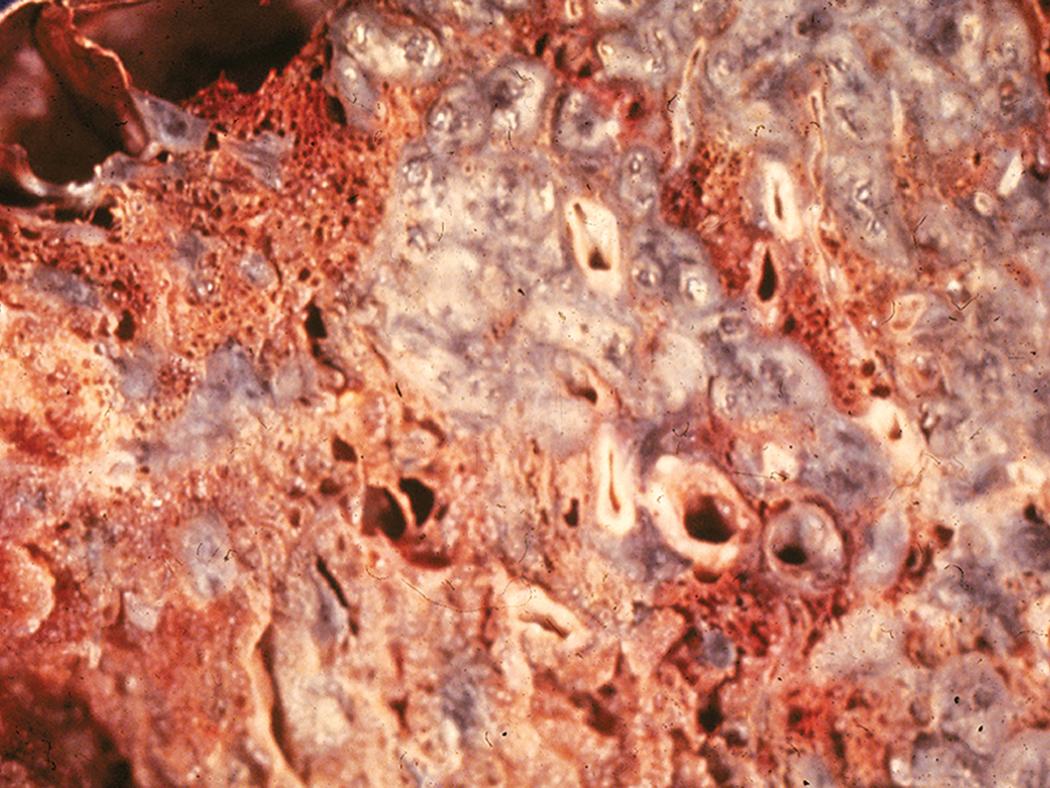

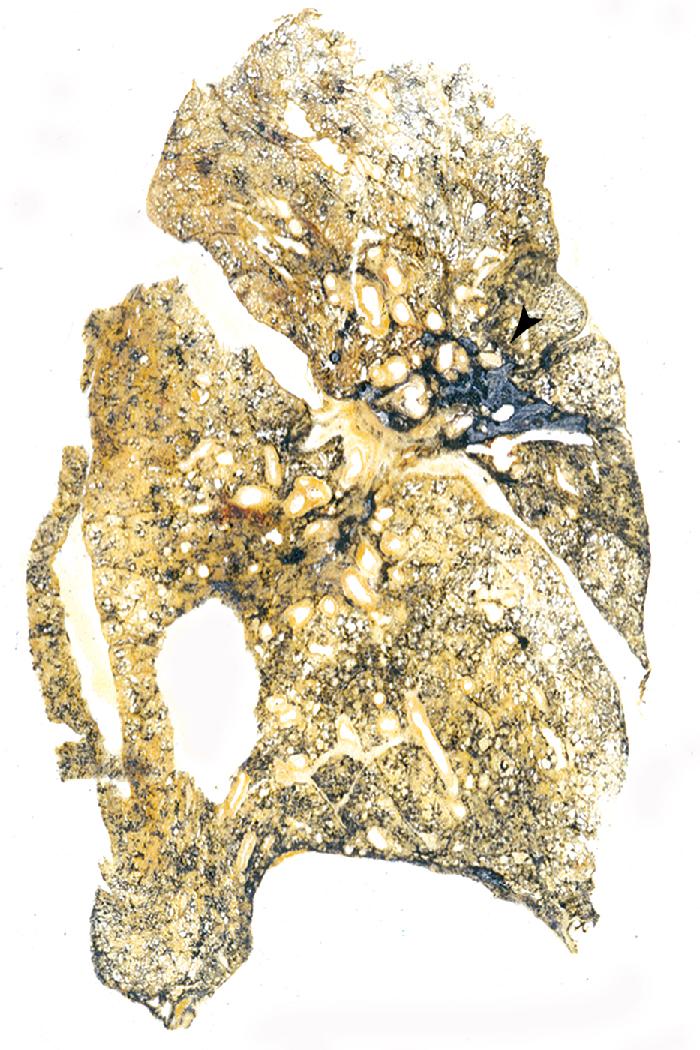
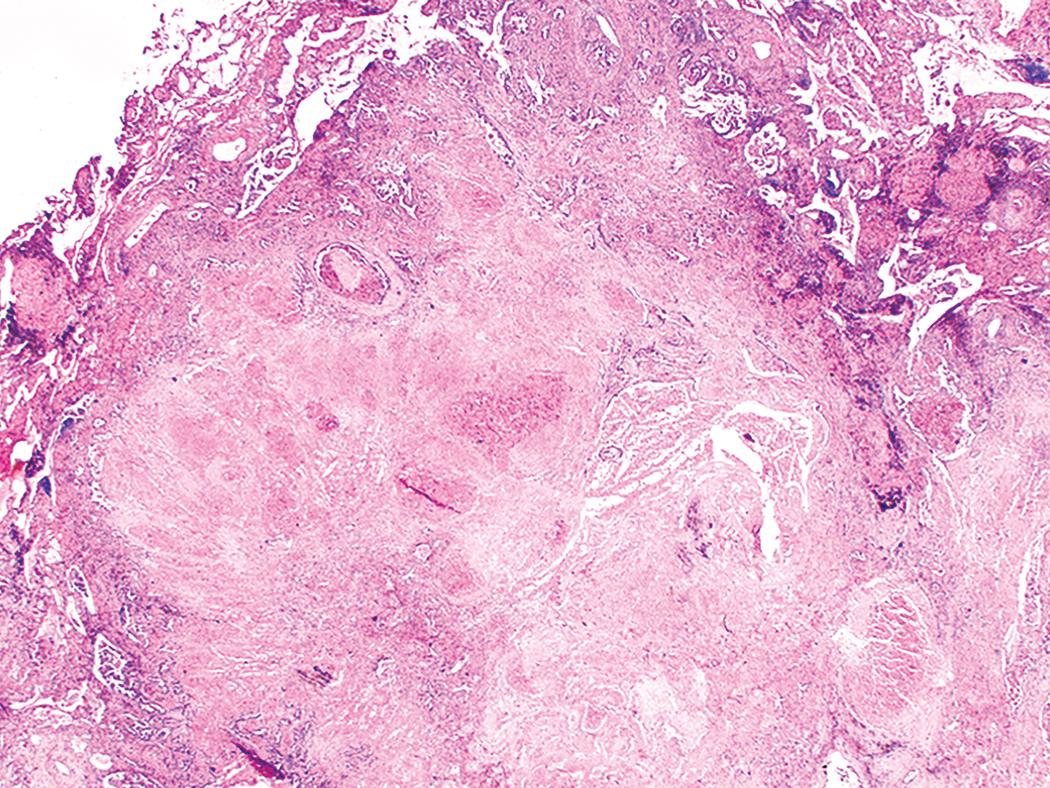
Histologically, silicotic nodules appear as sharply circumscribed nodules consisting of whorled, densely hyalinized collagen ( Fig. 10.5 ). More loosely arranged collagen bundles are typically found at the periphery of silicotic nodules. In recently formed lesions, macrophages form a mantle around the fibrotic center. Long-standing lesions may be calcified or even ossified ( Fig. 10.6 ). Silicotic nodules may develop anywhere in the lungs but typically are most numerous in the upper lung zones. Not uncommonly, they are concentrated beneath the pleura ( Fig. 10.7 ). Silicotic nodules can also protrude through the visceral pleura to its surface where they may macroscopically resemble drops of candle wax. Rarely, they appear as “pleural pearls” dangling into the pleural cavity by a fibrous strand attached to the pleural surface. There may also be extensive pleural fibrosis associated with macrophages that can simulate malignant mesothelioma at first glance ( Figs. 10.8 and 10.9 ). Regional lymph node involvement by silicotic nodules is common and can occur in the absence of parenchymal lung disease ( Fig. 10.10 ). Involved nodes occasionally undergo peripheral calcification, which has a characteristic eggshell appearance on radiography. The general consensus is that isolated nodal involvement, while indicative of silica exposure, should not be categorized as silicosis. Rarely, the mediastinum and/or peribronchial lymph nodes become engulfed by destructive silica dust-laden proliferative fibrosis, which has been referred to as silicotic fibrous pseudotumor. Acute silicosis typically resembles pulmonary alveolar proteinosis and is characterized by the presence of granular eosinophilic material filling the alveoli, alveolar ducts, and bronchioles ( Fig. 10.11 ). The granular proteinaceous exudate, which may show prominent cholesterol clefts, typically stains strongly positive with periodic acid-Schiff with diastase (PAS-D).
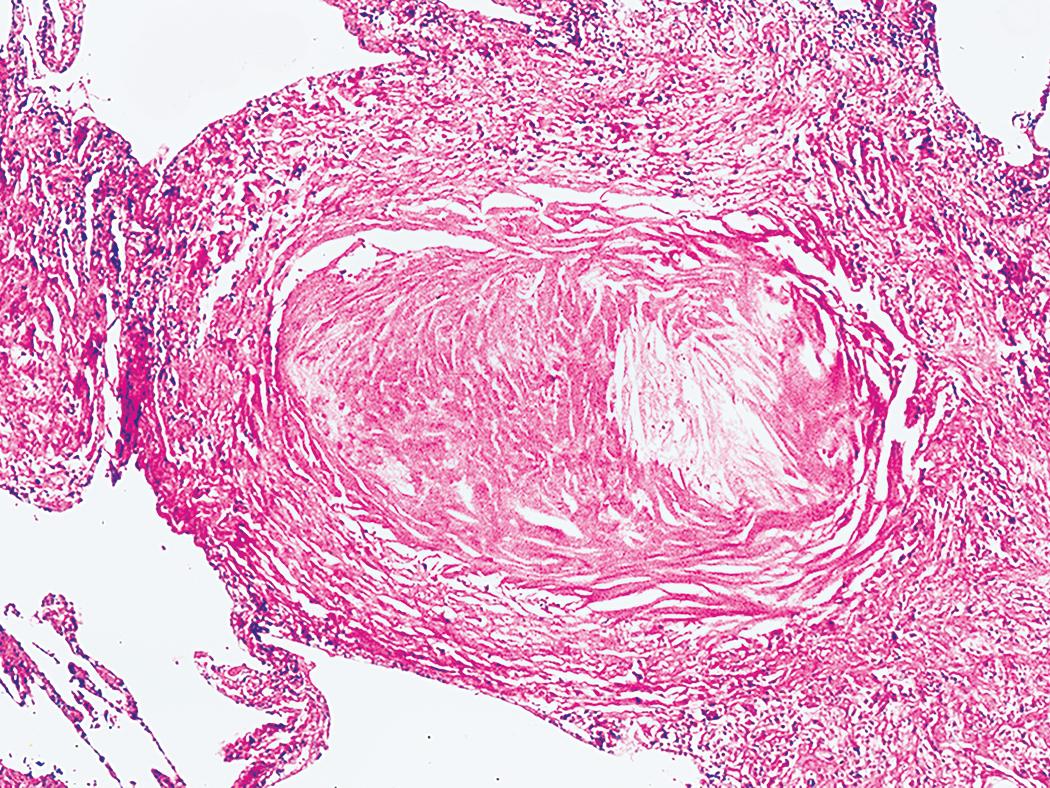
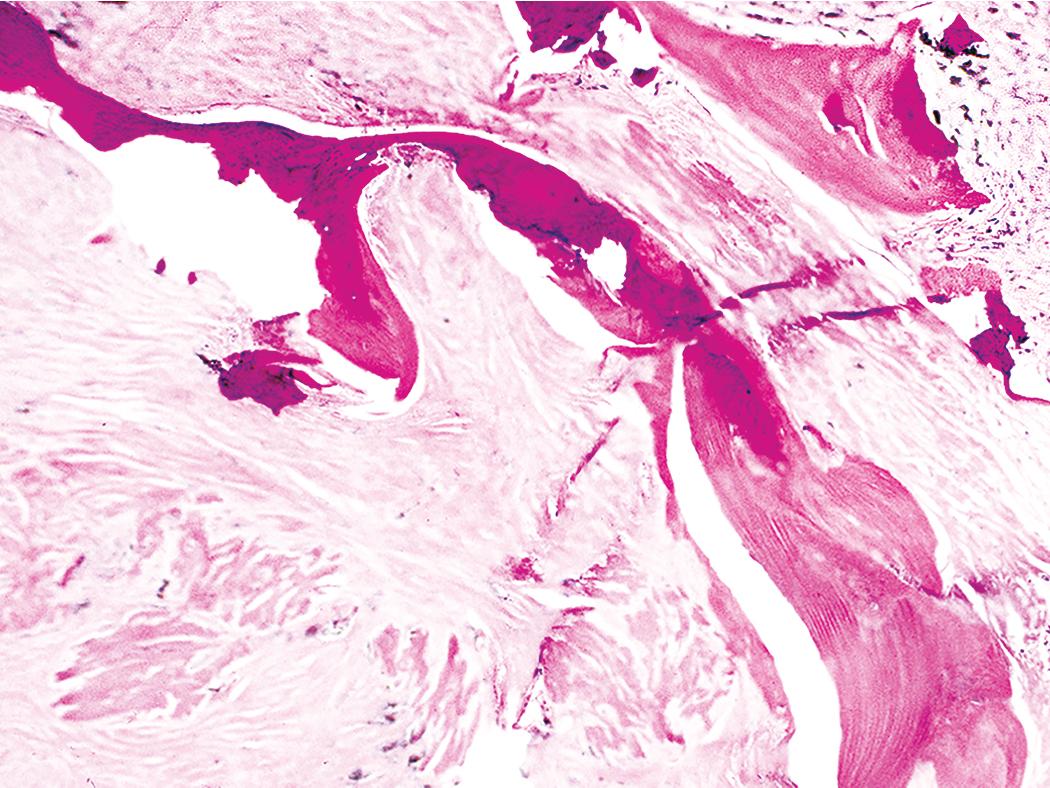
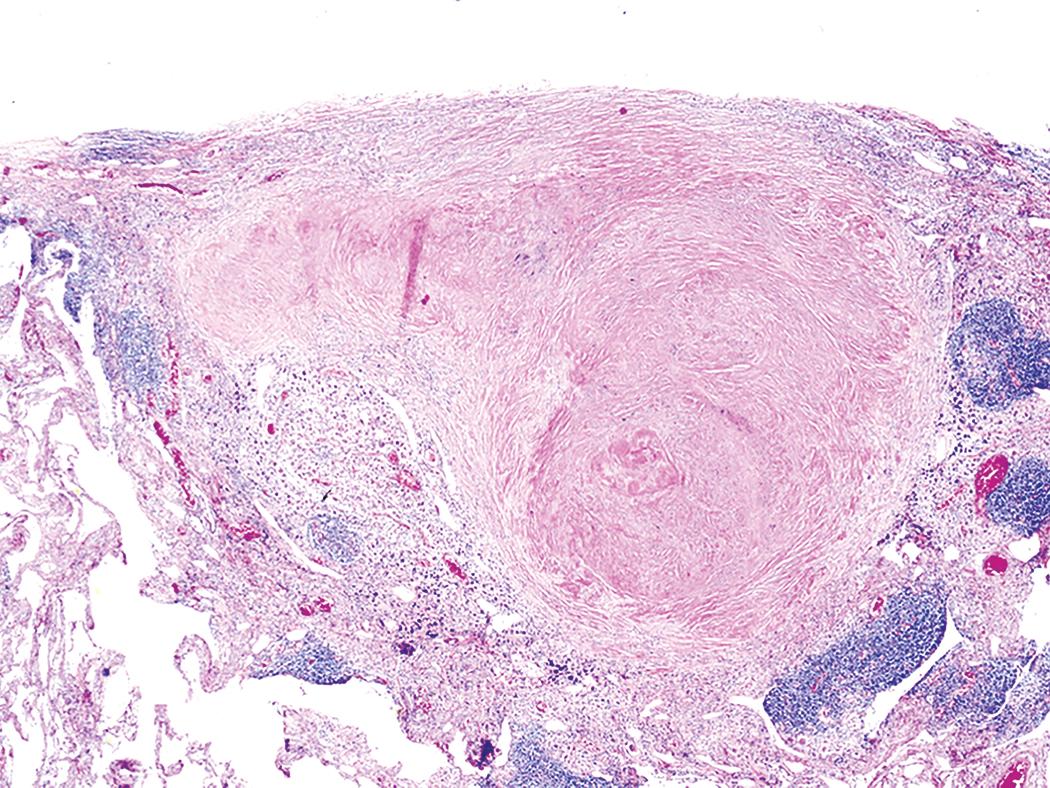
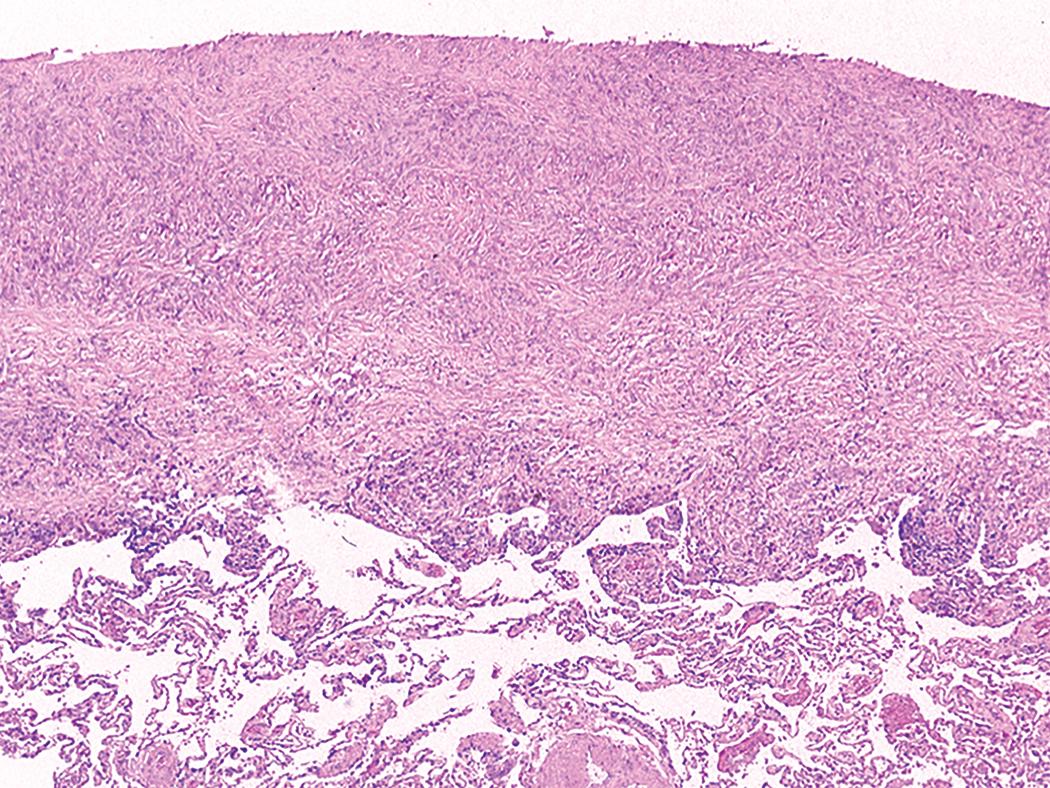
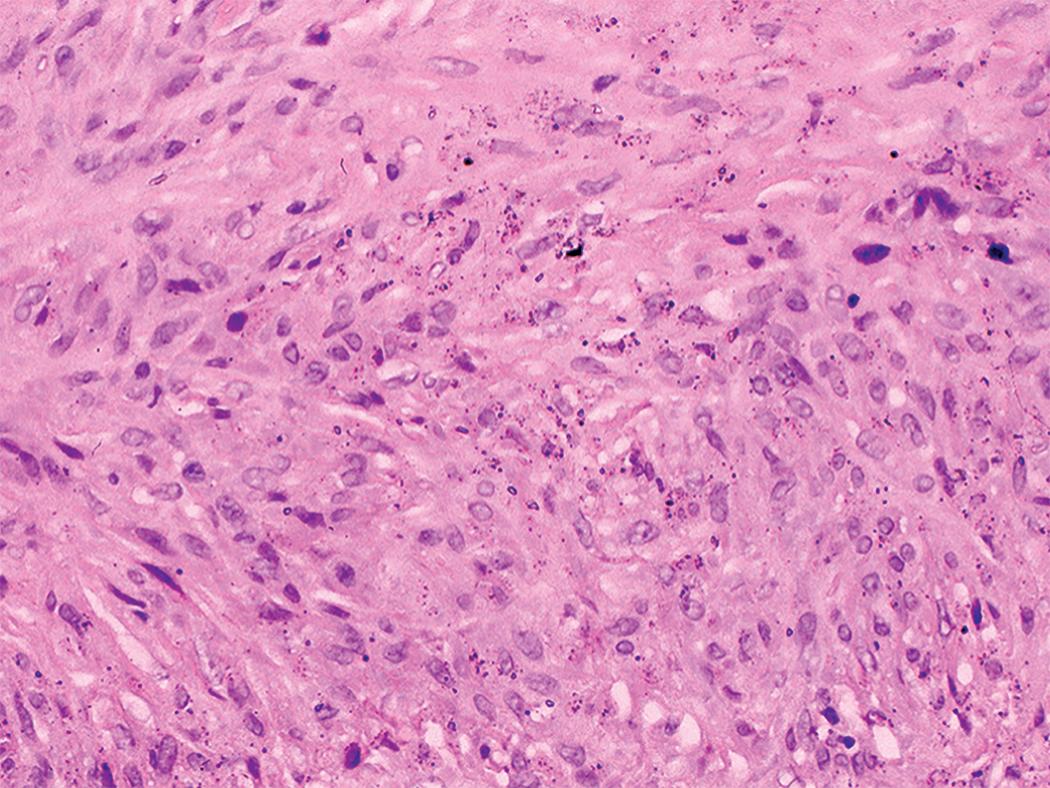
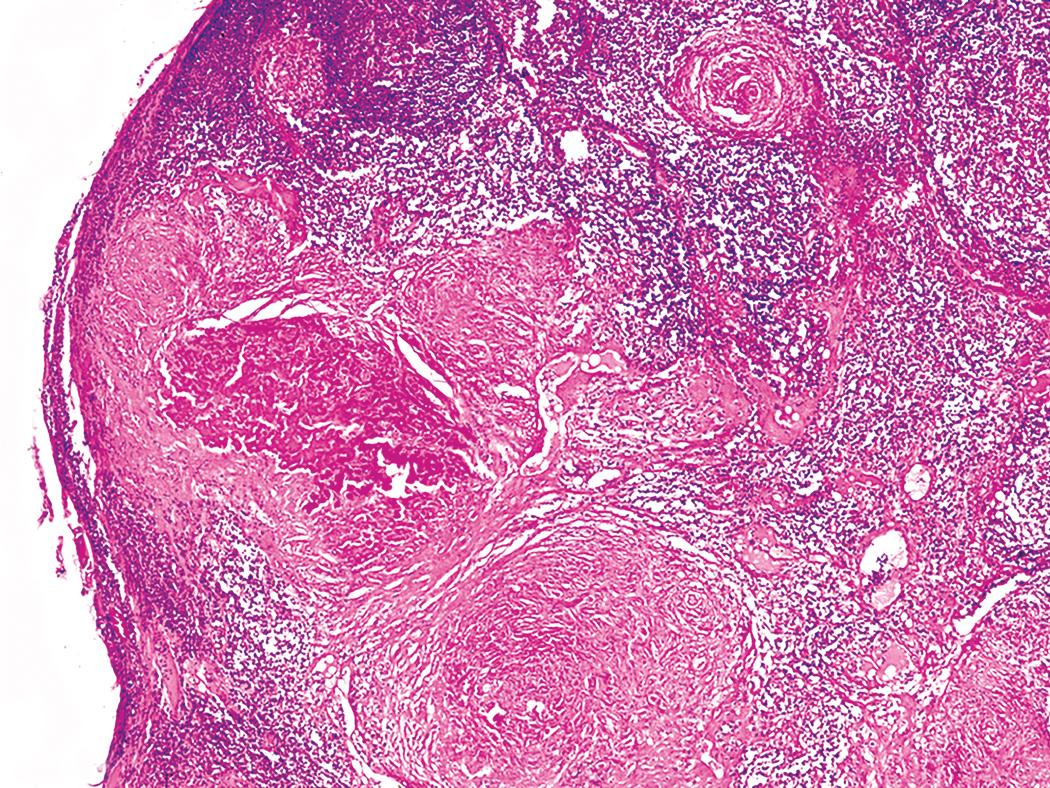
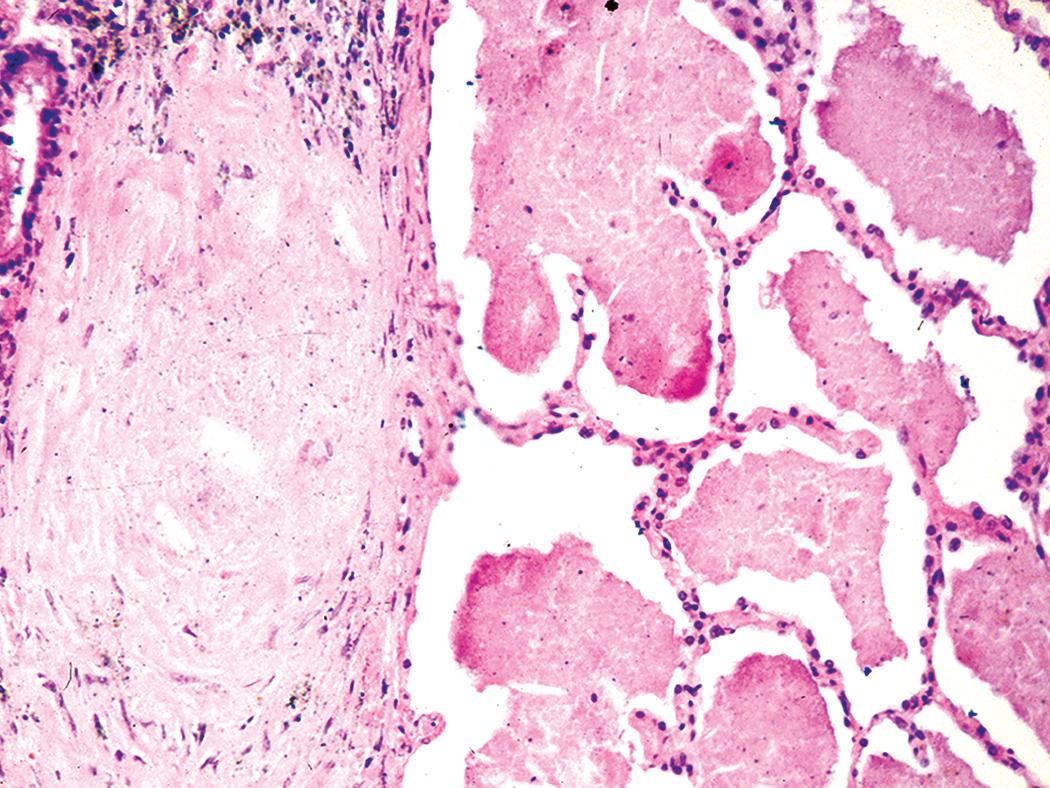
Examination with polarizing microscopy shows faintly birefringent particulates within the fibrotic nodules ( Fig. 10.12 ). Larger brightly birefringent particles, which represent silicates, may also be seen, but should not predominate (see Silicatosis section). On scanning electron microscopy, the particles appear angulated ( Fig. 10.13 ). Analytic electron microscopy with EDXA shows peaks solely for silicon ( Fig. 10.14 ).
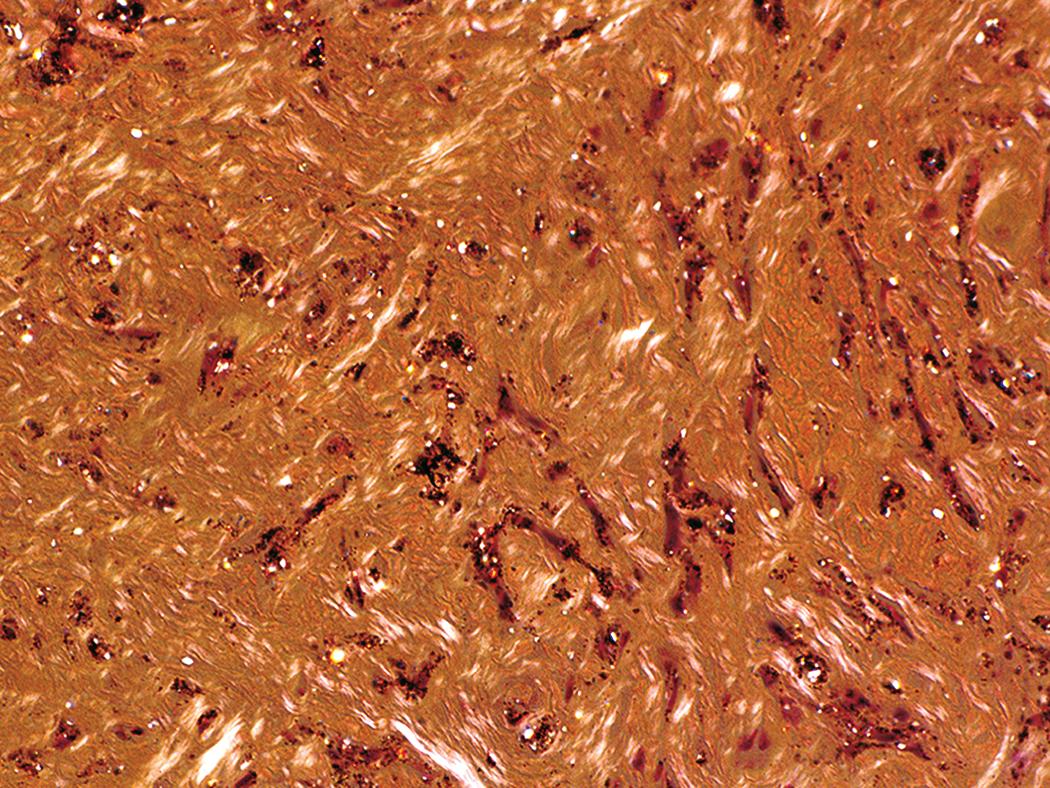
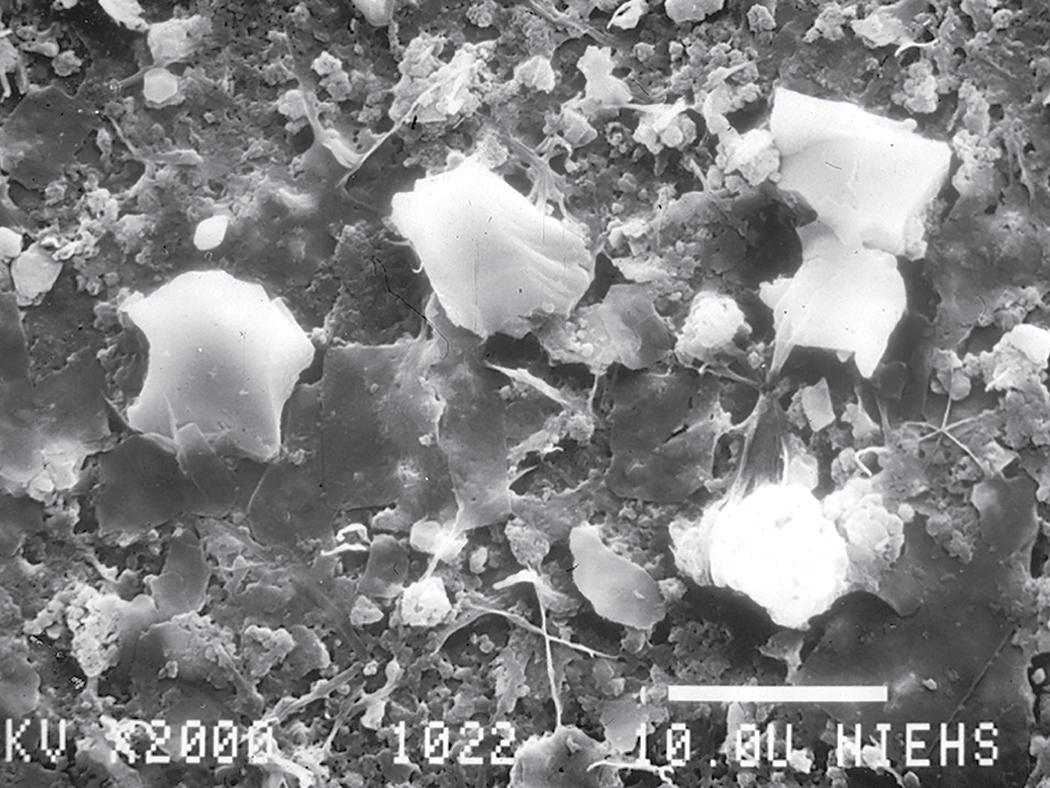
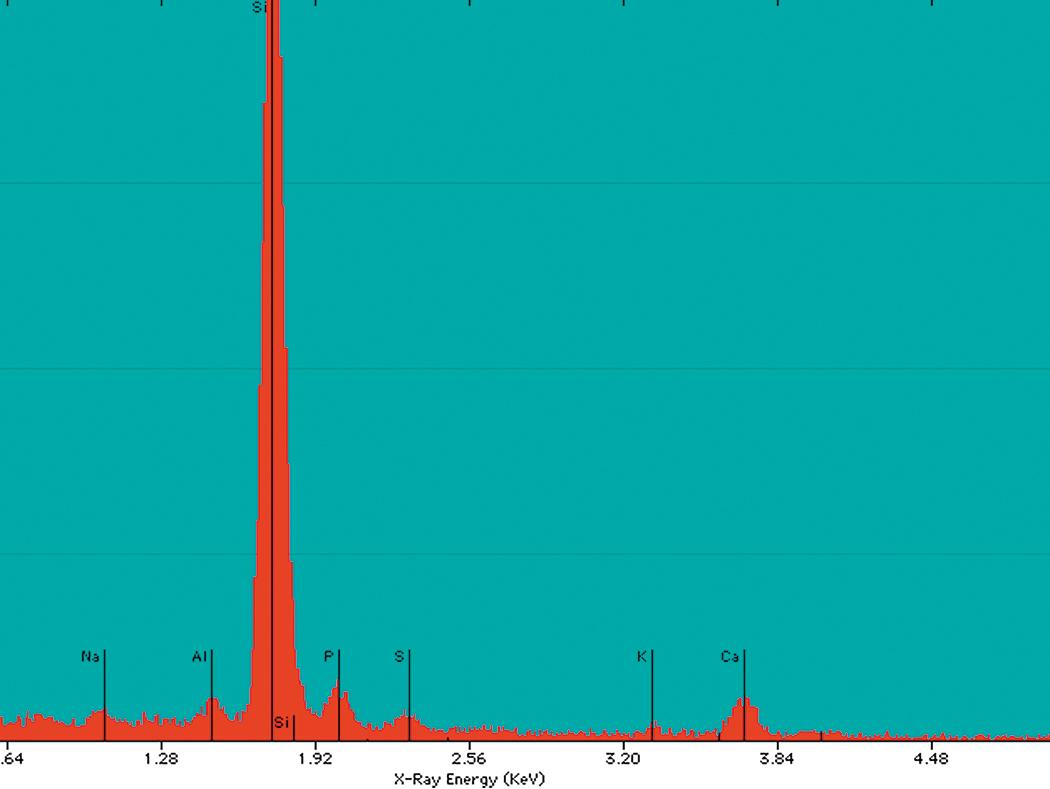
Silicotic nodules must be distinguished from the fibrotic nodules of burned out (healed) sarcoidosis, as well as healed mycobacterial and fungal infections, a classic example of which is so-called histoplasmoma. The presence of multinucleated giant cells and the absence of significant dust deposits favor sarcoidosis. Giant cells in sarcoidosis and other granulomatous processes sometimes contain variably shaped birefringent particles that represent endogenous calcium salts, such as calcium oxalate ( Fig. 10.15 ). , These particles should not be confused with the foreign material of pneumoconiosis. The presence of necrosis in association with giant cells favors an infectious etiology. Healed infectious granulomas are often solitary, in contrast to silicosis. Individuals with silicosis are at increased risk for acquiring tuberculosis and both processes may be present simultaneously. Concurrent tuberculosis infection is most likely to occur with conglomerate silicosis. The occasionally somewhat stellate appearance of the macrophage mantle in recently formed silicotic nodules may simulate Langerhans cell histiocytosis, but the latter does not contain whorled collagen.
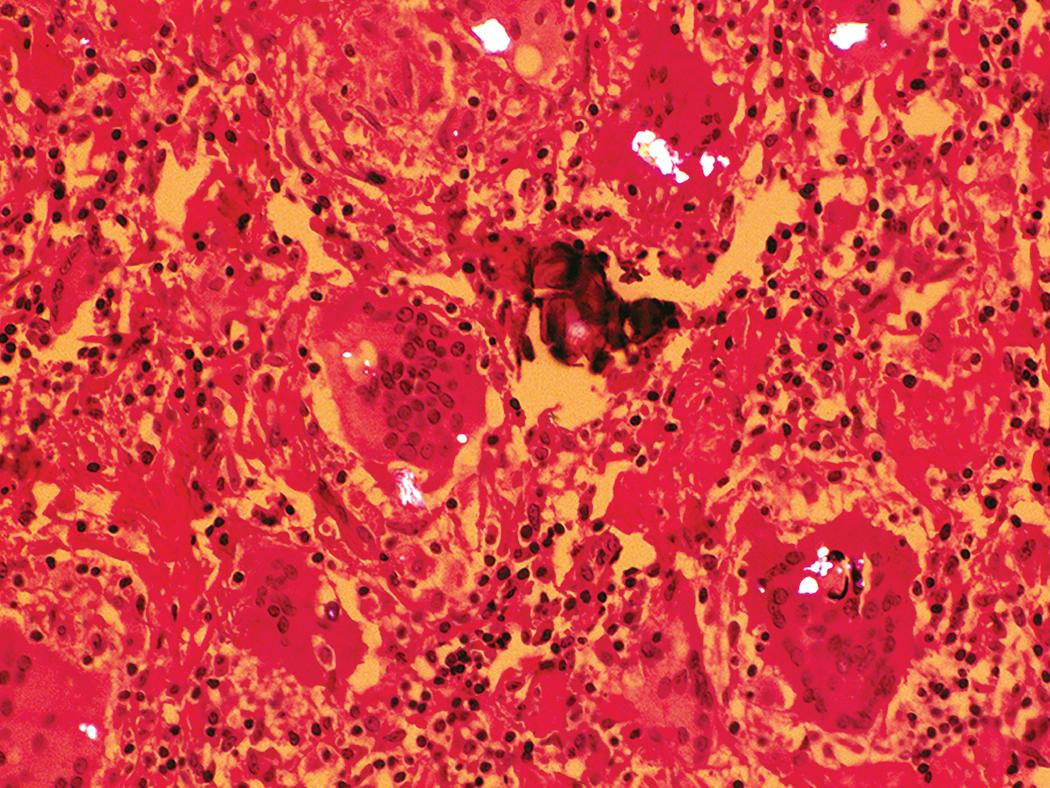
Rheumatoid pneumoconiosis, eponymously termed Caplan syndrome, was originally described in coal miners with rheumatoid arthritis. It can also be seen in individuals exposed to silica or silicates and reflects the presence of rheumatoid nodules in association with pneumoconiosis. The nodules demonstrate central necrosis with peripheral palisading of histiocytes, often in association with a rim of dust.
An extrathoracic location does not exclude silica as the etiology of fibrous nodules, as silicotic nodules have been reported in the liver, spleen, bone marrow, and abdominal lymph nodes. Extrathoracic involvement usually occurs in the setting of advanced pulmonary silicosis. The diagnostic yield of transbronchial biopsy in silicosis is low, which is likely explained by the firm nodules being pushed aside by the biopsy forceps.
Coal worker’s pneumoconiosis (CWP), also known as black lung disease, occurs in individuals involved in the mining of coal. The nature of the disease is related to the intensity and duration of exposure, host factors, and the specific duties of the miner. Workers involved in drilling the ceiling of mine shafts or constructing communicating shafts are exposed to greater amounts of silica than those working at the coal face.
In recent decades, there has been an alarming resurgence in CWP. Rapidly progressive disease is being seen in miners who are younger and/or have been mining for shorter durations than in the past. The reasons for this upturn appear to be multifactorial and include decreased adherence to and relaxed oversight of permissible dust exposure limits in US coal mines, as well as an increased prevalence of thin seam and slope mining. In thin seam and slope mining, rock is dug through to reach coal seams, which can liberate significant amounts of crystalline silica dust.
Individuals range from asymptomatic with simple CWP to markedly dyspneic with PMF. The latter is associated with hypoxemia and cor pulmonale and may be fatal. ,
In comparison to normal lungs, CWP is characterized by increased pigmentation resulting from the deposition of coal dust ( Figs. 10.16–10.18 ). Superimposed on a background of diffusely increased pigment are foci of accentuated pigmentation on the pleural surface and within the lung parenchyma. In some cases, palpable nodules are present within the lung parenchyma and usually are most numerous in the upper lung zones. These nodules are grossly similar to silicotic nodules except that they are black rather than slate gray ( Fig. 10.19 ). The most advanced cases of CWP feature PMF. Macroscopically, PMF in CWP features confluent areas of irregular fibrosis, typically in the upper to middle lung zones that have the consistency of vulcanized rubber ( Fig. 10.20 ). Cavitation may occur in areas of PMF, and its presence suggests superimposed tuberculosis.
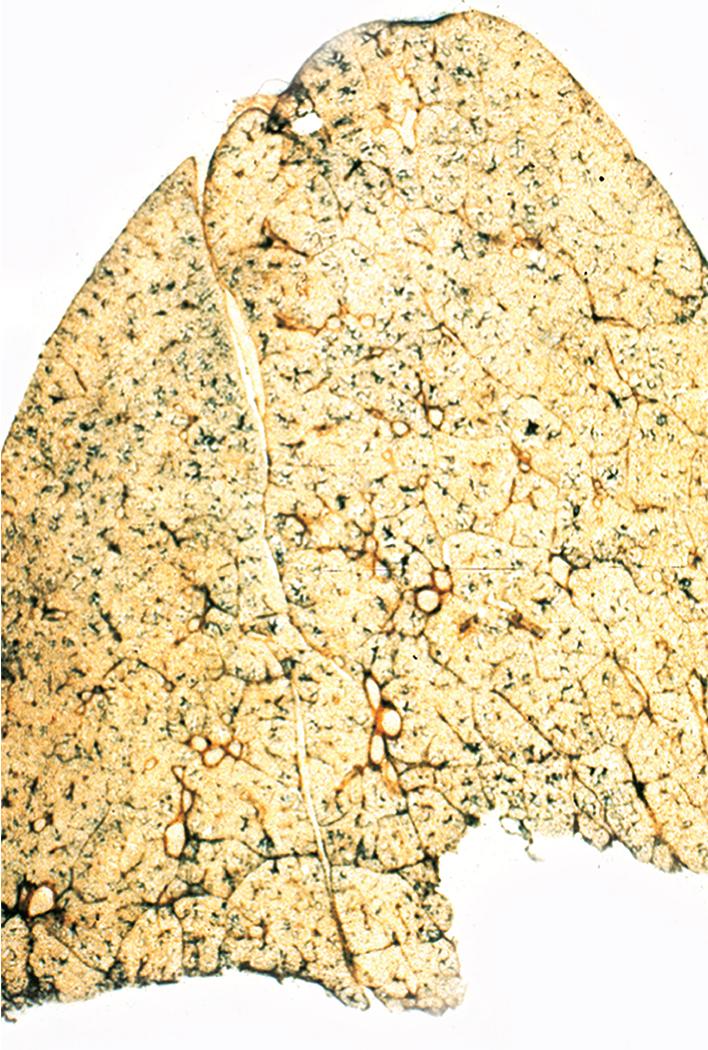
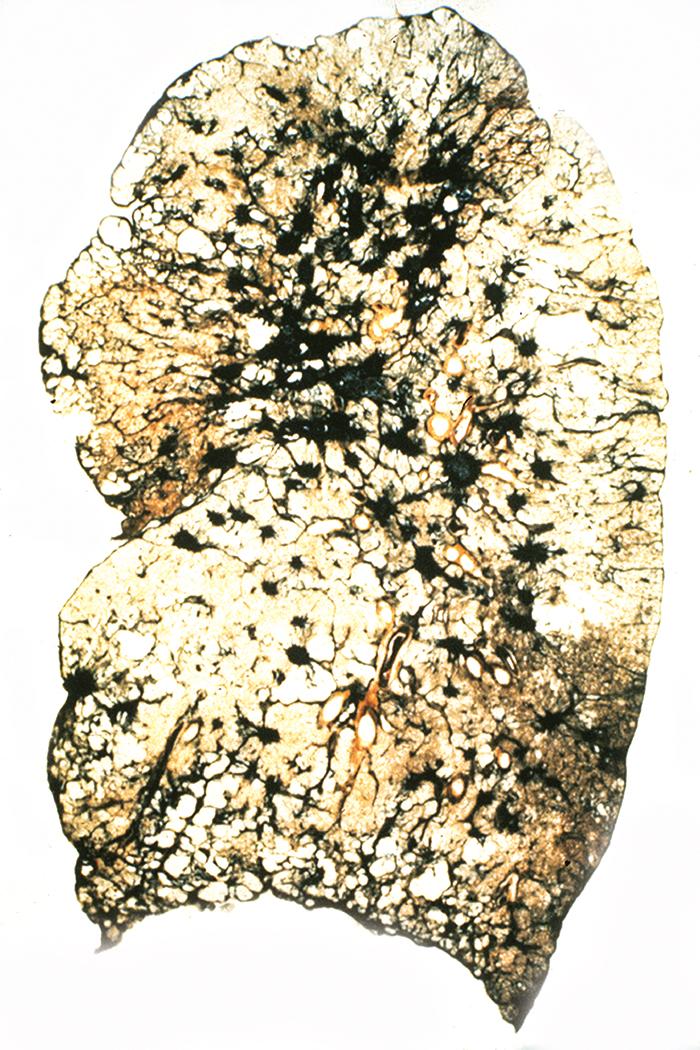
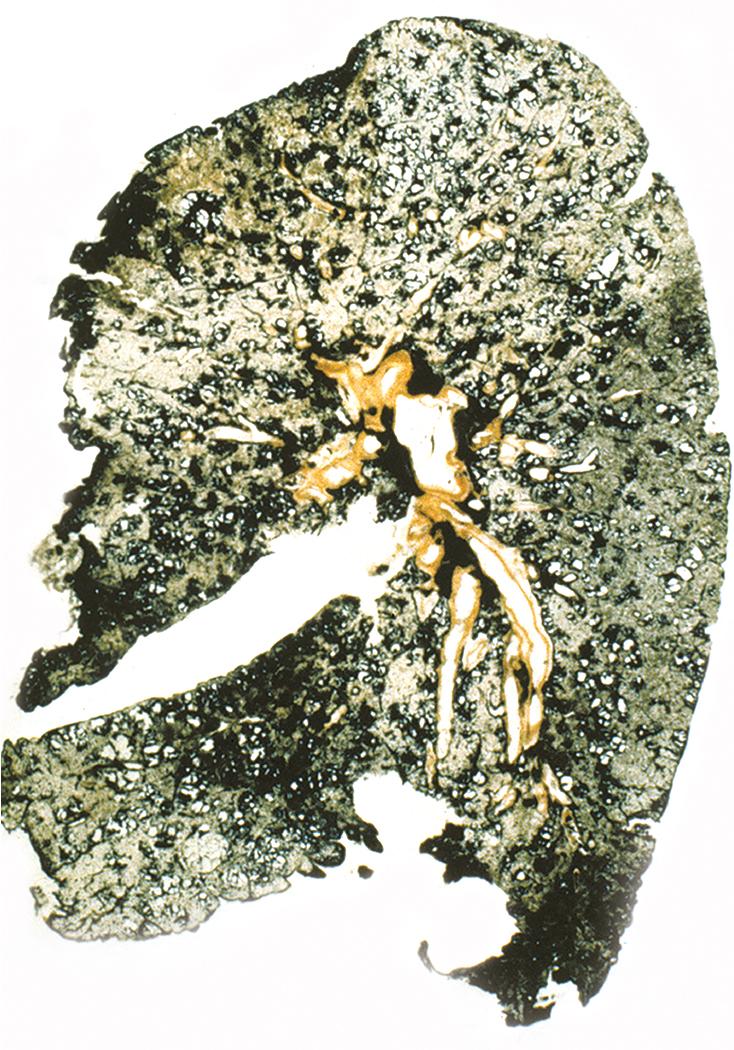
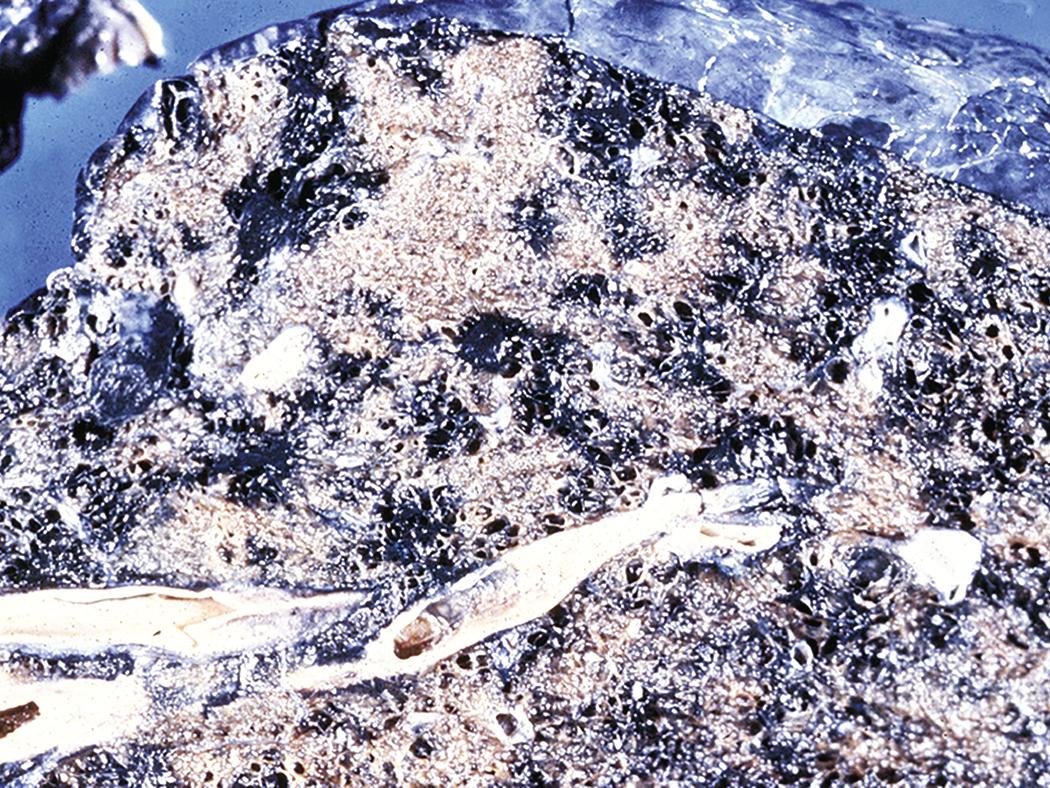
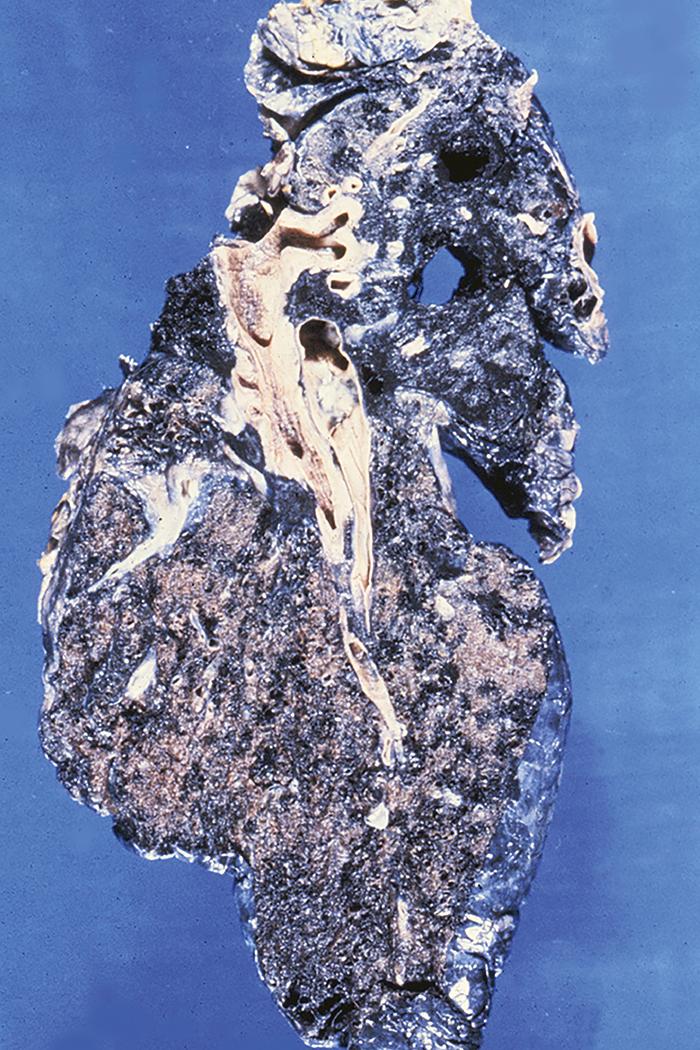
The histologic hallmark of CWP is the coal dust macule ( Fig. 10.21 ). Coal dust macules consist of discrete 1 to 4 mm collections of interstitial pigment in the vicinity of respiratory bronchioles that have minimal to no associated collagen deposition and are generally nonpalpable. Areas of emphysematous destruction, referred to as focal emphysema, are typically present at the periphery of macules. Coal nodules may also be present within the lung parenchyma. They are larger (usually >4 mm) and have more fibrosis than macules and are not confined to the respiratory bronchioles. , , Although reminiscent of silicotic nodules, coal nodules have a collarette of pigmented macrophages that imparts a “Medusa head” appearance ( Fig. 10.22 ). Dust-laden macrophages may also be present within alveolar spaces and pigment deposits can occur anywhere along the lymphatic routes of the lung including the secondary lobular septa and in the pleura. Lymph nodes frequently contain numerous pigmented macrophages and may also demonstrate coal nodules.
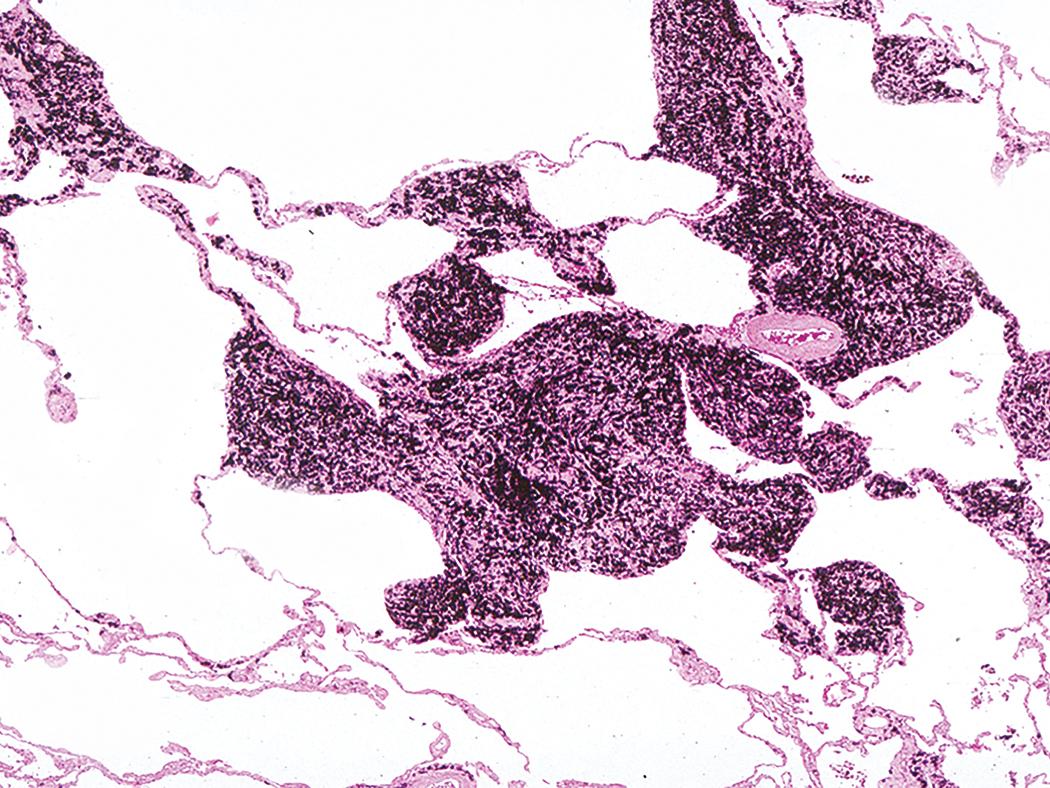
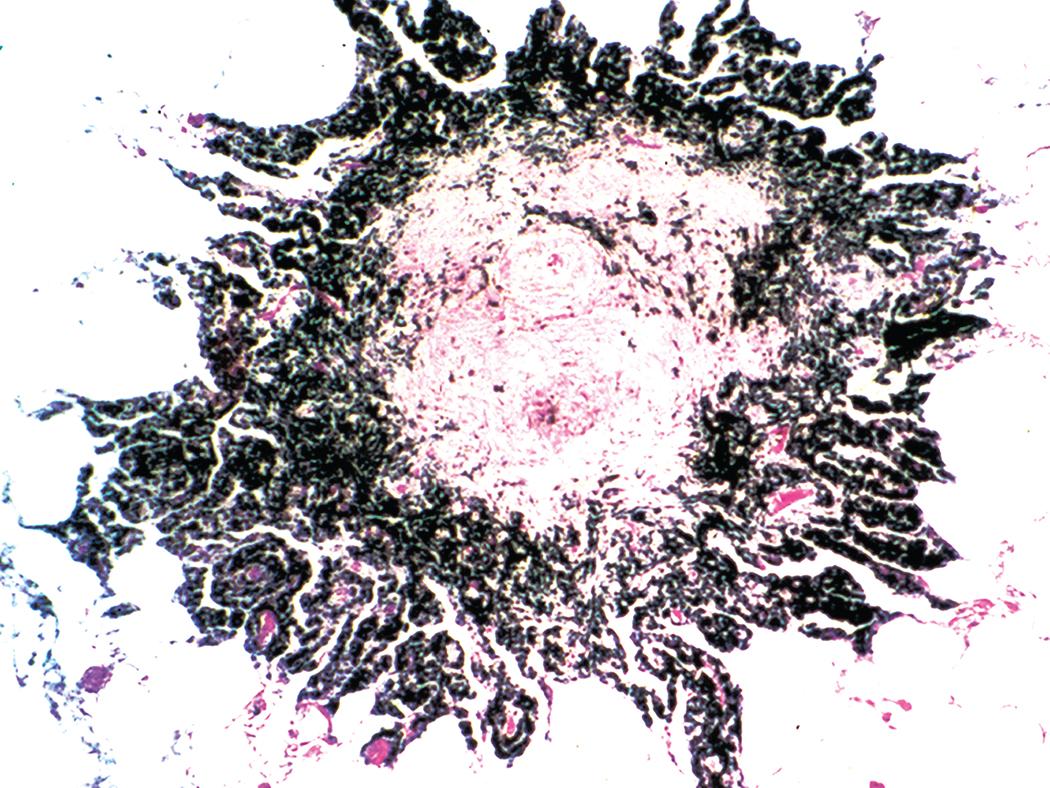
The term simple CWP is used for cases that show coal dust macules in combination with focal emphysema. In complicated CWP, there is coalescence of coal dust macules along with areas of PMF ( Fig. 10.23 ) consisting of collagen bundles arranged in a haphazard distribution intermixed with abundant pigment ( Figs. 10.24 and 10.25 ). As discussed in the preceding section on silicosis, differing minimum pathologic size criteria have been proposed for PMF. , Although some authors define it as 2 cm, others argue that 1 cm or greater better aligns with the International Labour Office (ILO) Classification of Radiographs of Pneumoconiosis definition of large opacities. , Features of simple CWP are usually present in the background in cases with PMF. PMF may transgress anatomic boundaries, such as blood vessels, and may cross interlobar fissures. Vascular obliteration is common within areas of PMF and ischemia may be the cause of cavitation in some cases.
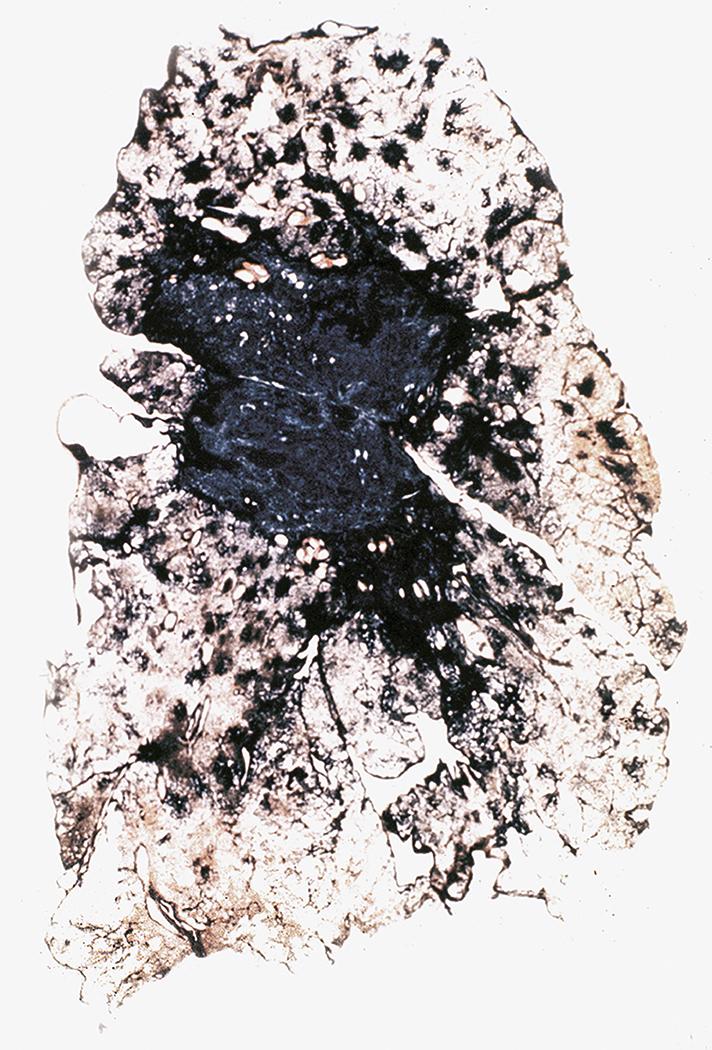
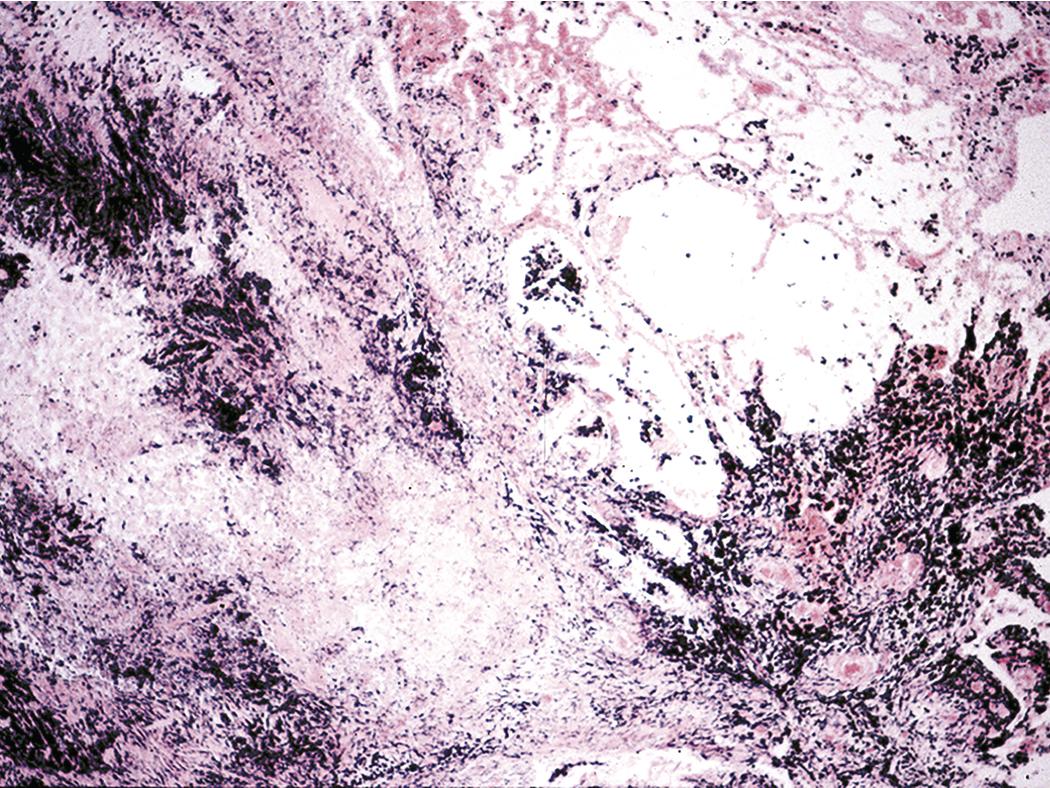
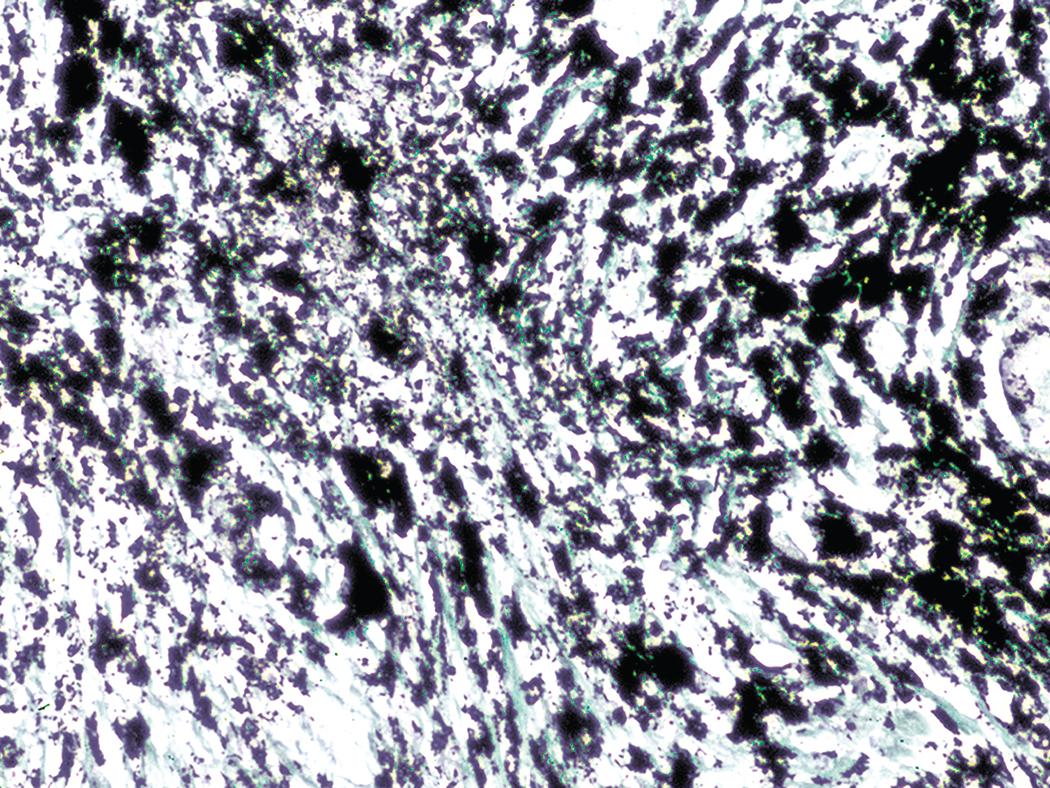
Examination with polarizing microscopy typically shows numerous faintly to brightly birefringent particulates within a background of black pigment ( Fig. 10.26 ). This appearance reflects the mixed nature of coal dust, which is composed of amorphous carbon, silicates, and silica. Carbon in and of itself is not considered fibrogenic. The presence of silica in coal dust is responsible for the formation of silicotic nodules and is an important factor in the pathogenesis of PMF. The outsize role of silica in disease development is reflected in a contemporary study of lung tissue from coal miners in which silicotic nodules predominated and classic lesions of simple CWP were seen in only a minority of cases. Ferruginous bodies are sometimes seen in the lungs of coal workers, typically within the alveolar spaces ( Fig. 10.27 ). These may be distinguished from true asbestos bodies by virtue of their black carbonaceous cores ( Fig. 10.28 ). Tuberculosis may also complicate CWP ( Fig. 10.29 ).
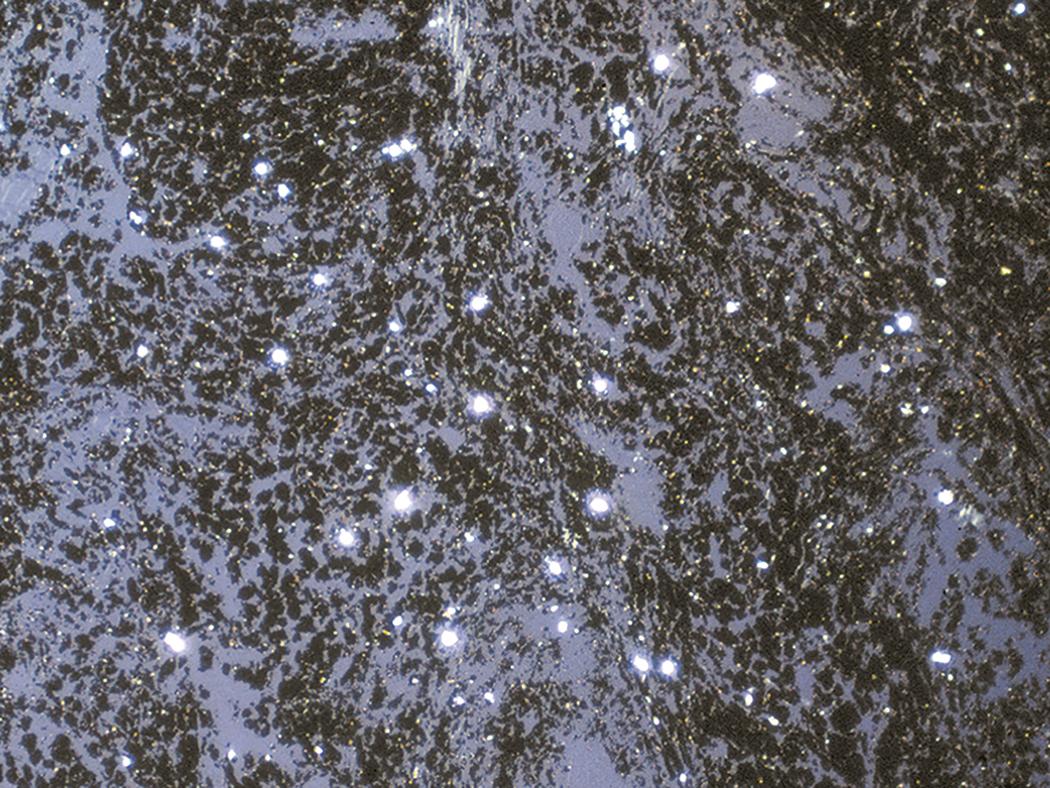
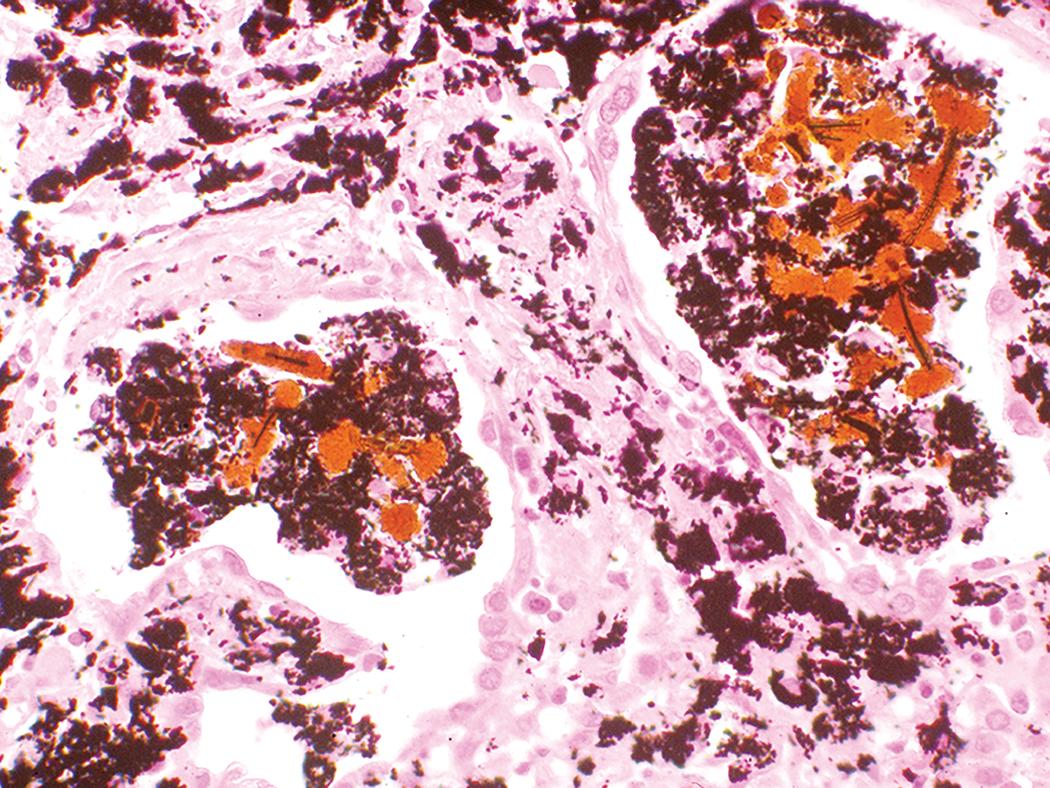
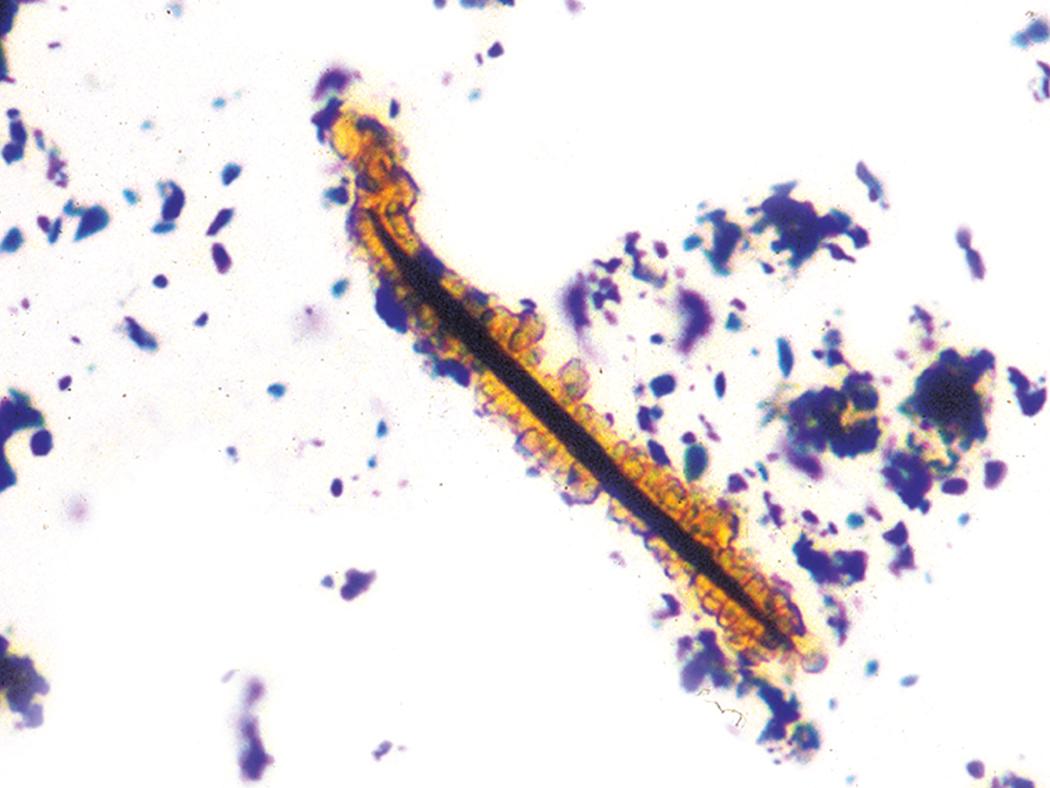
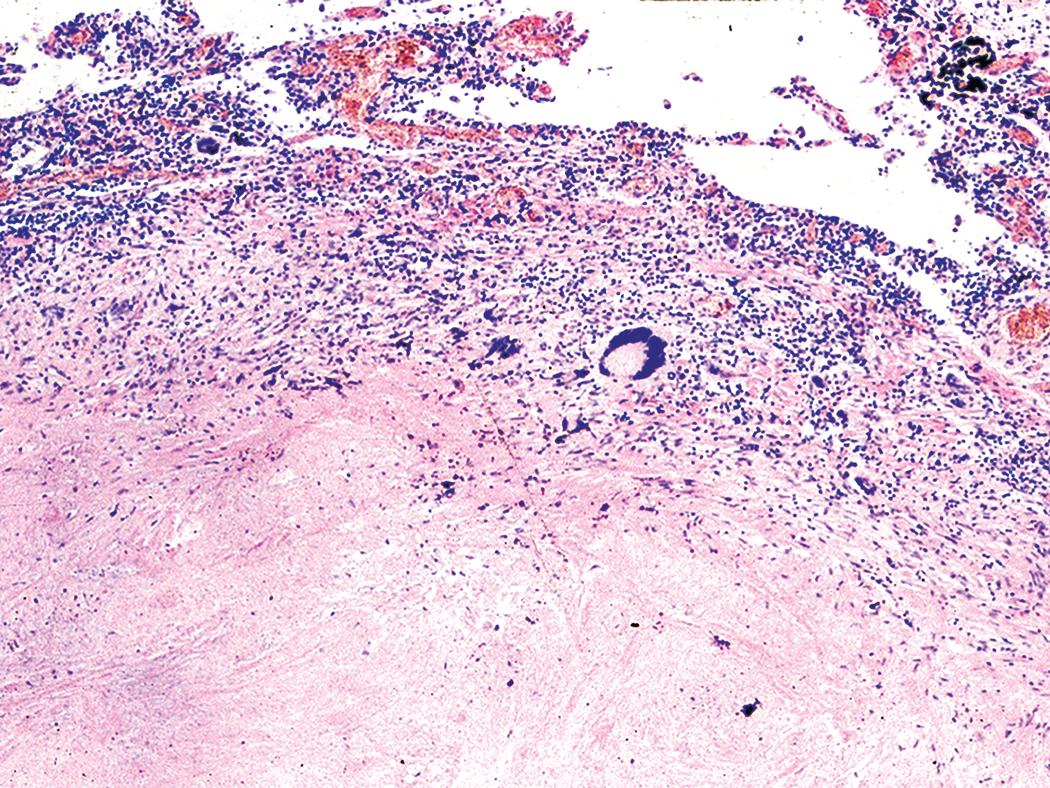
CWP must be distinguished from the black carbonaceous pigment deposition that occurs in urban dwellers and cigarette smokers and from graphite pneumoconiosis. The extent of pigmentation in normal persons is a function of environmental exposure to carbon-containing dust and the natural ability of the lung to rid itself of particulates. Distinction from CWP is somewhat a matter of degree, but the presence of bona fide coal dust macules is indicative of CWP. Perivascular and peribronchiolar deposition of black carbonaceous pigment is often referred to as anthracosis. However, use of this term is discouraged outside of the setting of evaluating cases for the purposes of determining disability or death due to coal mining. Under the Black Lung Benefits Act, anthracosis is included in the US federal regulatory definition of pneumoconiosis. Graphite pneumoconiosis appears similar to CWP, but graphite is crystalline, whereas the carbon present in coal is amorphous ( Fig. 10.30 ). A giant cell reaction to the crystalline carbon of graphite assists in this distinction. Increased deposition of black carbonaceous pigment accompanied by interstitial fibrosis has also been reported in an individual with indoor woodstove exposure. Transbronchial biopsy may be useful in the diagnosis of CWP, but as areas of nodular fibrosis or PMF can be missed by such sampling, it is not useful for assessing disease severity.

Asbestosis is defined as pulmonary interstitial fibrosis caused by the inhalation of asbestos fibers. Substantial exposures to asbestos can occur in a variety of occupational settings, including the mining and milling of asbestos, the manufacture of asbestos-containing products, and the use of products containing asbestos. Workers who may be involved in the use of asbestos-containing products include insulators, shipyard workers, railroad workers, power plant workers, US Navy and Merchant Marine seamen, oil and chemical refinery workers, construction workers, steel and other molten metal workers, and paper mill workers, among others ( Box 10.2 ). An increased incidence of asbestosis has also been reported among workers at an asbestos-contaminated vermiculite mine and its nearby residents. Household contacts of asbestos workers may be exposed to asbestos brought home on the workers’ clothing.
Asbestos mining and milling
Asbestos products manufacture
Construction
Glass and ceramic manufacture
Insulation
Oil and chemical refineries
Paper mills
Power plants
Railroad operation/maintenance
Shipbuilding/ship repair
Steel and other molten metal manufacture
US Navy/Merchant Marine
Individuals with asbestosis range from asymptomatic to severely dyspneic at rest with cor pulmonale that may prove fatal. The time between initial exposure to asbestos and the development of symptoms in individuals with long-term exposure (latency period) is typically decades. However, there are rare reports of disease manifesting after short latency and/or brief intense asbestos exposure. Pulmonary function testing typically shows restrictive changes with reduced diffusion capacity. Individuals with asbestosis who smoke cigarettes have a markedly increased risk for developing lung cancer. Although the pleural and parenchymal changes caused by asbestos may be recognized on plain films, high-resolution computed tomography (HRCT) is considered to be a more sensitive and specific modality for the radiographic evaluation of asbestosis.
The fibrosis in asbestosis typically demonstrates a fine reticular pattern that can be seen macroscopically. However, the lungs can range from normal in gross appearance to severely scarred and shrunken ( Fig. 10.31 ) with evidence of honeycombing. Asbestosis is usually most severe in the lower lung zones and is frequently accompanied by overlying visceral pleural fibrosis. Pleural plaques are also present in the vast majority of cases. Like silicotic lesions involving the pleura, pleural plaques often resemble candle wax drippings macroscopically ( Fig. 10.32 ). However, whereas silicotic lesions are situated on the visceral pleura in a distribution that corresponds to anatomic lobules of the underlying lung, pleural plaques commonly involve the parietal pleura, as well as the diaphragm. Although the presence of diffuse pleural fibrosis and pleural plaques suggests asbestos is the etiology of pulmonary fibrosis, the term asbestosis should not be applied to cases in which these pleural abnormalities occur in the absence of parenchymal disease.
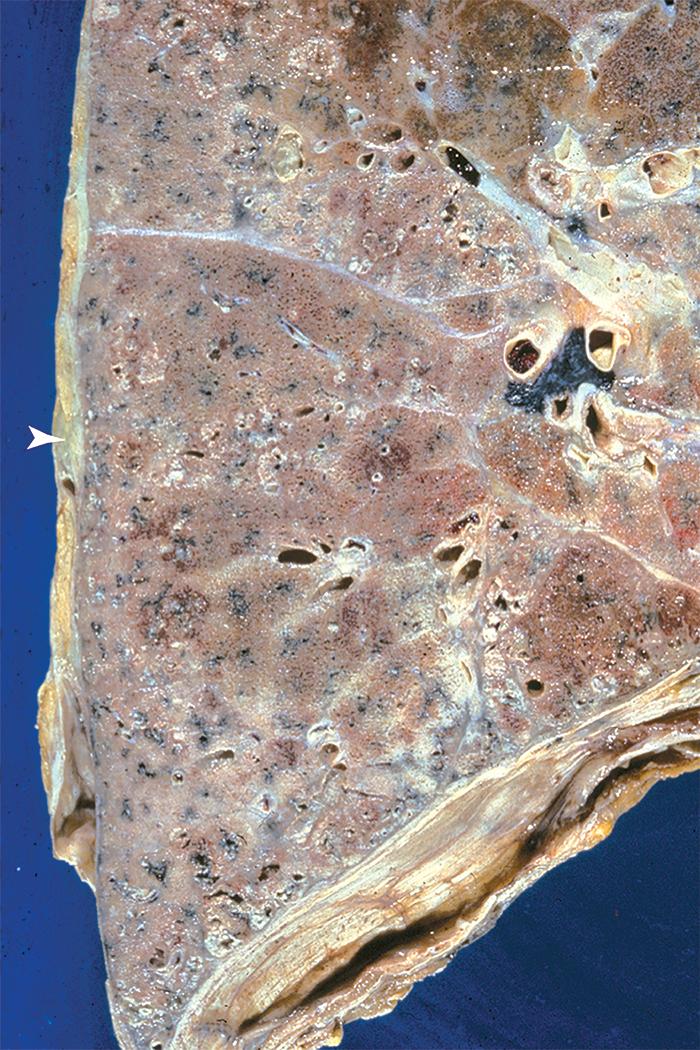
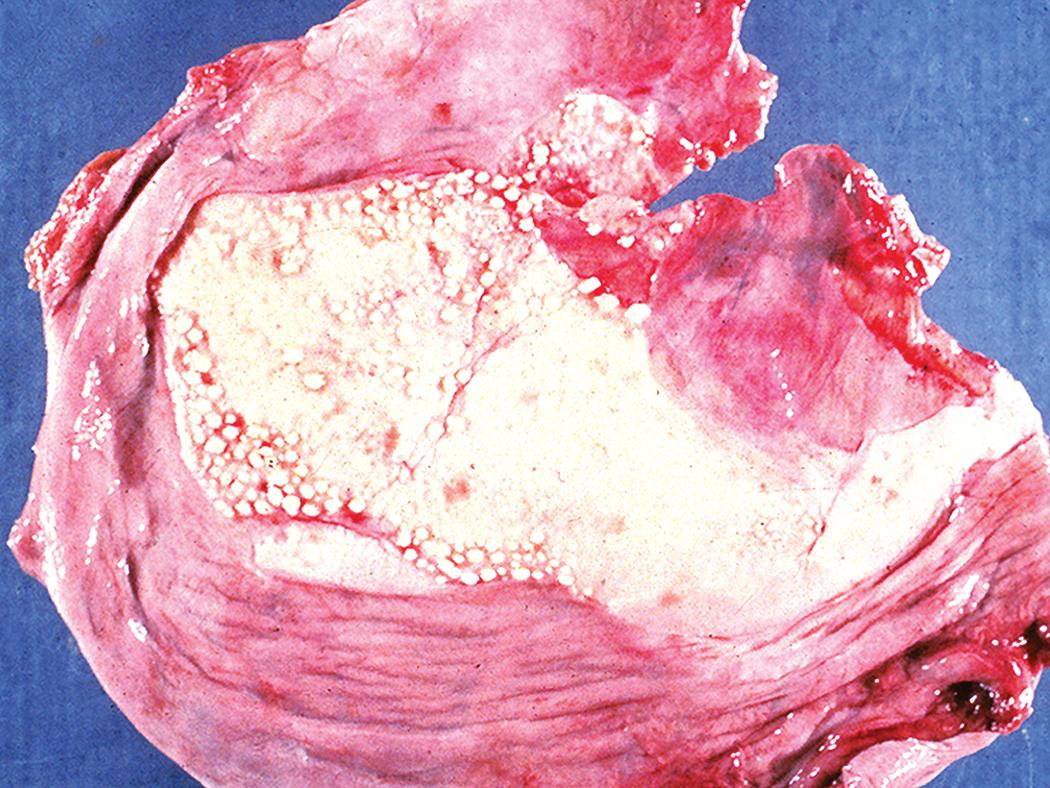
Histologically, the earliest manifestation of asbestos-associated parenchymal disease is fibrosis of the walls of respiratory bronchioles accompanied by asbestos bodies, for which the designation asbestos airways disease has been proposed ( Box 10.3 and Figs. 10.33 and 10.34 ). As the fibrosis progresses in asbestosis, it extends distally beyond the bronchiolar walls to the alveolar ducts and proximally to the membranous (terminal) bronchioles. The fibrosis also extends radially to involve alveolar septa distant from the respiratory bronchiole ( Fig. 10.35 ). In the most advanced cases of asbestosis, honeycomb fibrosis is present ( Fig. 10.36 ), characterized by 0.5 to 1 cm in diameter fibrous-walled cysts lined by bronchiolar-type epithelium that often contain pools of mucus. However, some investigators have reported a disconnect between diffuse fibrosis with honeycomb changes and peribronchiolar fibrosis, hence questioning this sequence of fibrosis progression. Alveolar macrophages are sometimes so prominent as to suggest a diagnosis of desquamative interstitial pneumonia (DIP). In some cases, multinucleated giant cells may be identified within either the interstitium or the alveolar spaces ( Fig. 10.37 ). Rarely, hyperplastic alveolar type 2 pneumocytes may contain cytoplasmic hyaline ( Fig. 10.38 ) reminiscent of that found in the cytoplasm of hepatocytes in alcoholic liver disease. This finding is not specific for asbestosis.
Grade 0: No appreciable peribronchiolar fibrosis or fibrosis confined to the bronchiolar walls
Grade 1: Fibrosis confined to the walls of respiratory bronchioles and the first tier of adjacent alveoli
Grade 2: Extension of fibrosis to involve alveolar ducts and/or ≥2 tiers of alveoli adjacent to the respiratory bronchiole, with sparing of at least some alveoli between adjacent bronchioles
Grade 3: Fibrotic thickening of the walls of all alveoli between ≥2 adjacent respiratory bronchioles
Grade 4: Honeycomb changes
a An average score is obtained for an individual case by adding the scores for each slide (0–4) and then dividing by the number of slides examined.
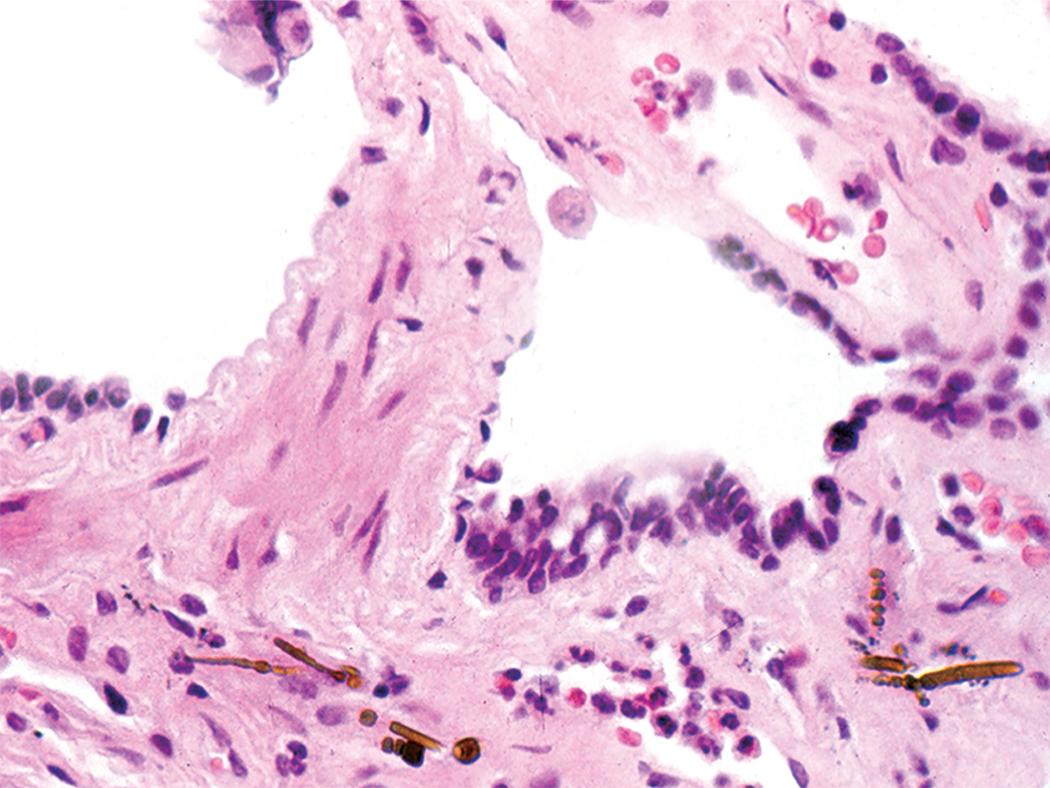
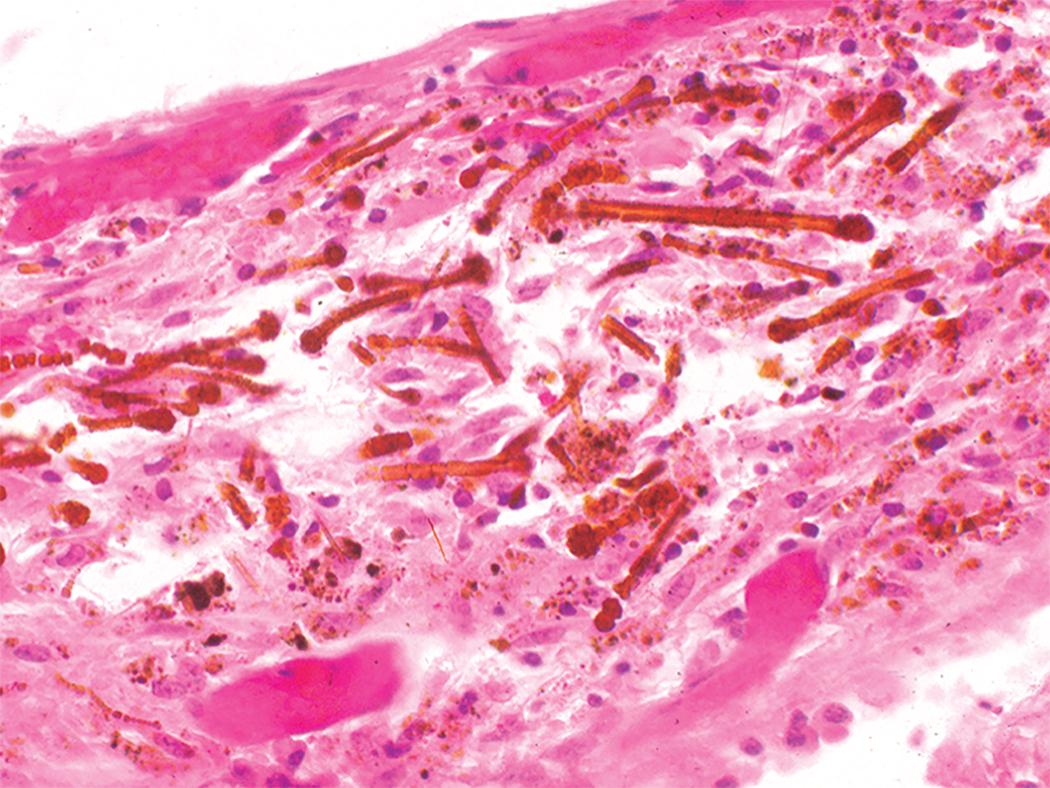
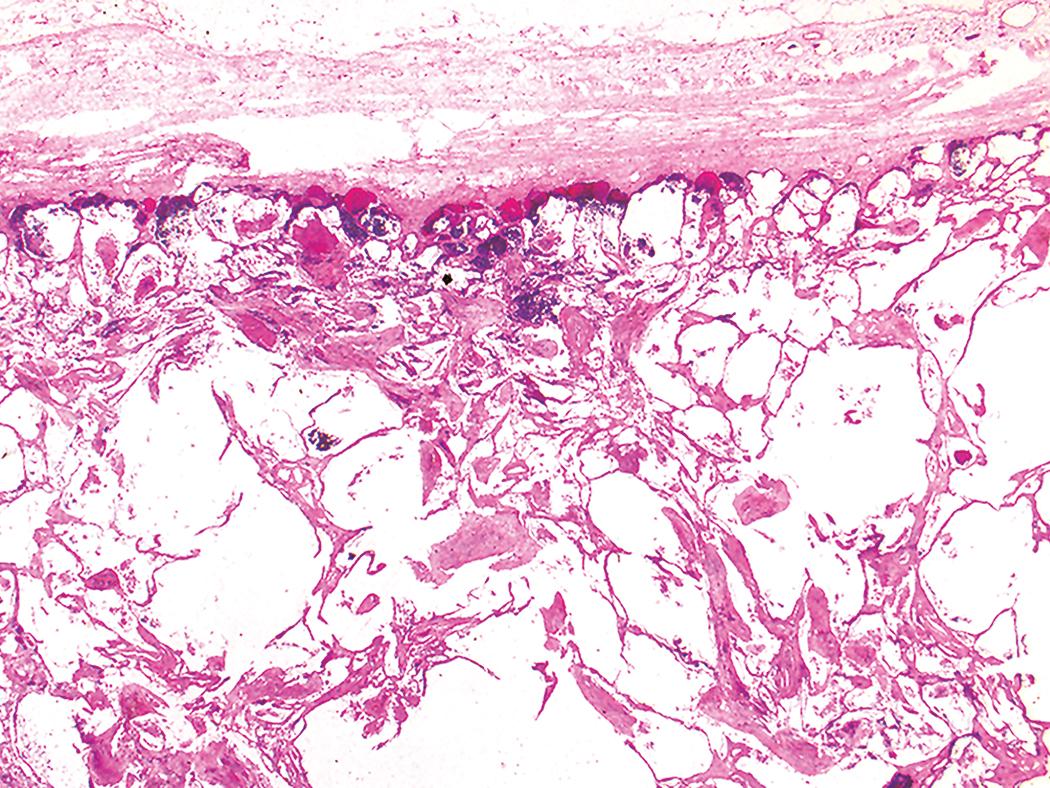
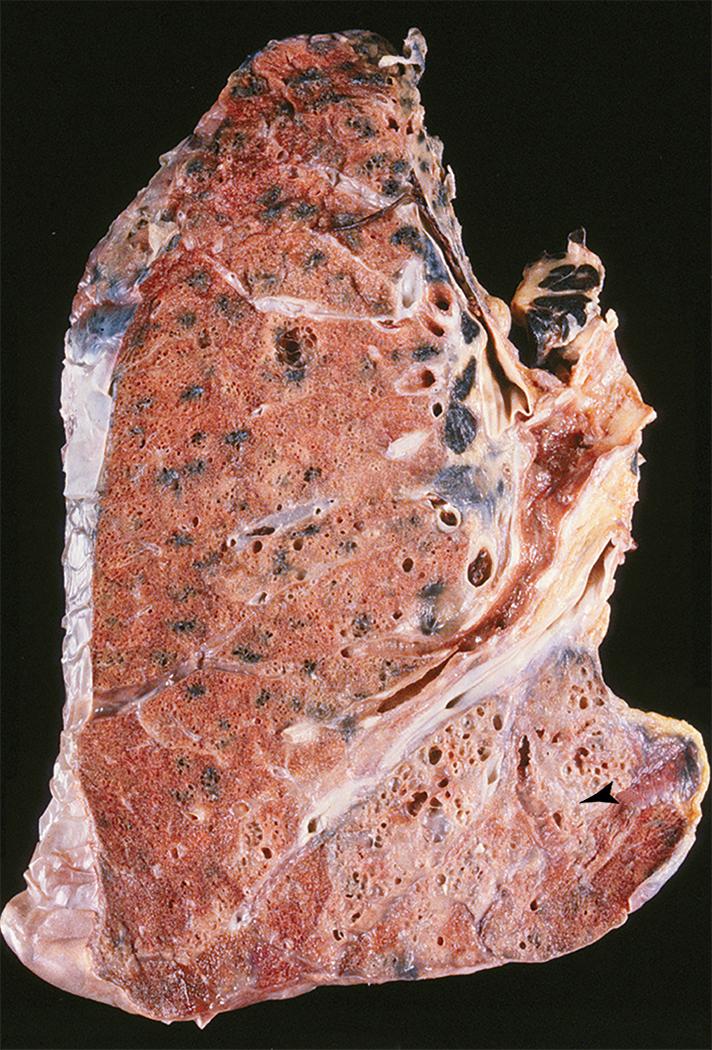

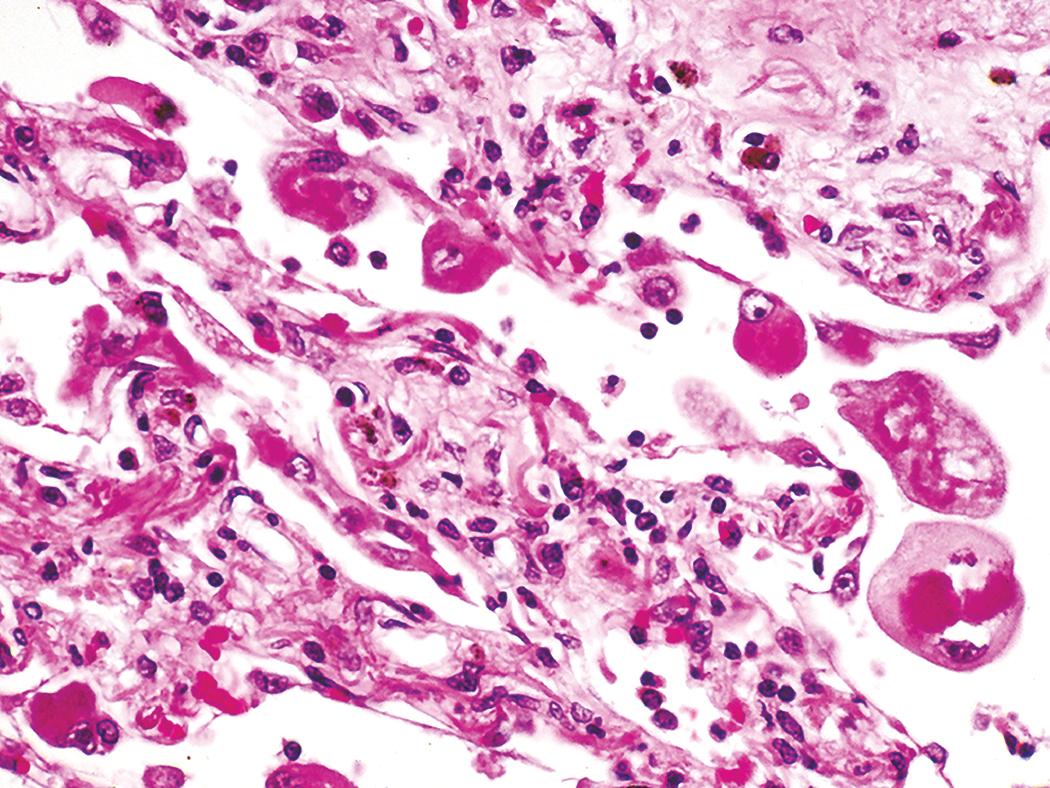
The hallmark of asbestos exposure is the asbestos body, a rodlike, beaded, or dumbbell-shaped structure with a golden-brown coating and a thin translucent core. Asbestos bodies are typically found in the peribronchiolar interstitium ( Fig. 10.39 ), but with heavy exposure they also may be seen in alveolar spaces ( Fig. 10.40 ). Polarizing microscopy is not useful for the detection of asbestos in histologic sections. A minimum of two asbestos bodies per cm 2 , in conjunction with an appropriate pattern of alveolar septal fibrosis, in well-inflated lung tissue away from lung carcinoma or mass lesions, is required for a histologic diagnosis of asbestosis. , Detection of asbestos bodies may be facilitated by the use of iron stains, which impart a deep blue color ( Fig. 10.41 ). Asbestos bodies may also be seen in sputum ( Fig. 10.42 ) and thoracic lymph nodes ( Fig. 10.43 ) of individuals with heavy exposure to asbestos. Pleural plaques consist of layers of acellular hyalinized collagen arranged in a “basket-weave” pattern that sometimes show areas of calcification ( Fig. 10.44 ). Asbestos-related diffuse pleural fibrosis may also show this pattern or appear as compact layers of collagen. A mild lymphocytic infiltrate sometimes accompanies the fibrosis.
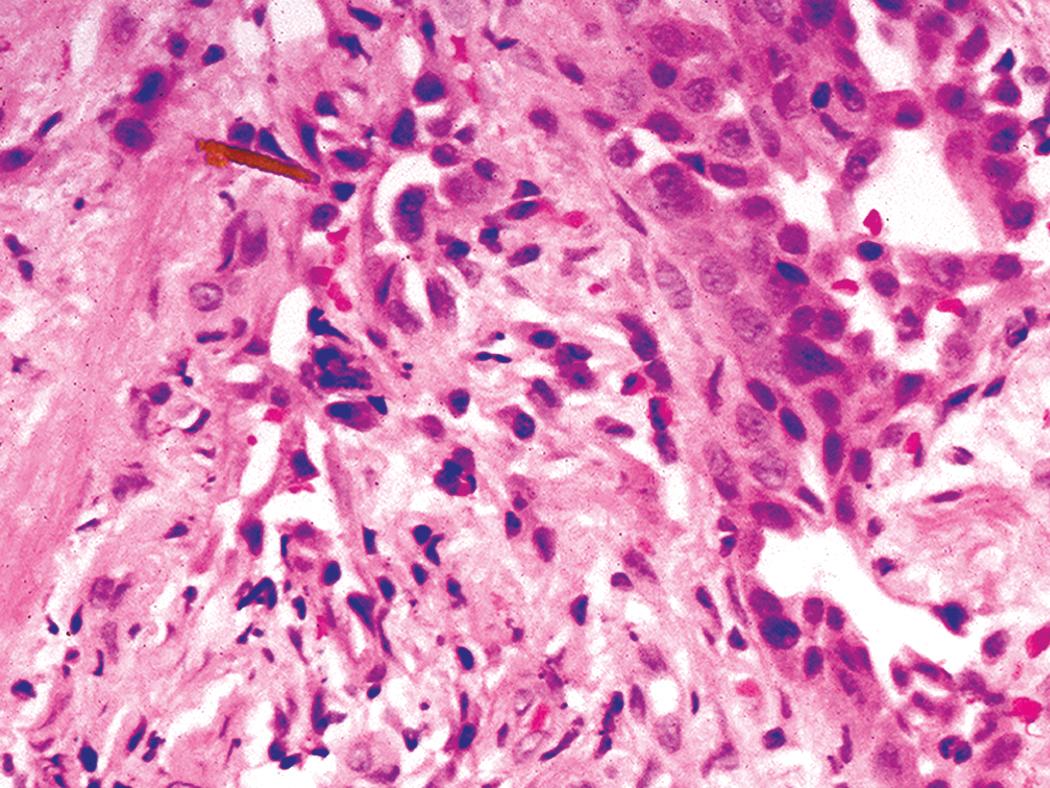
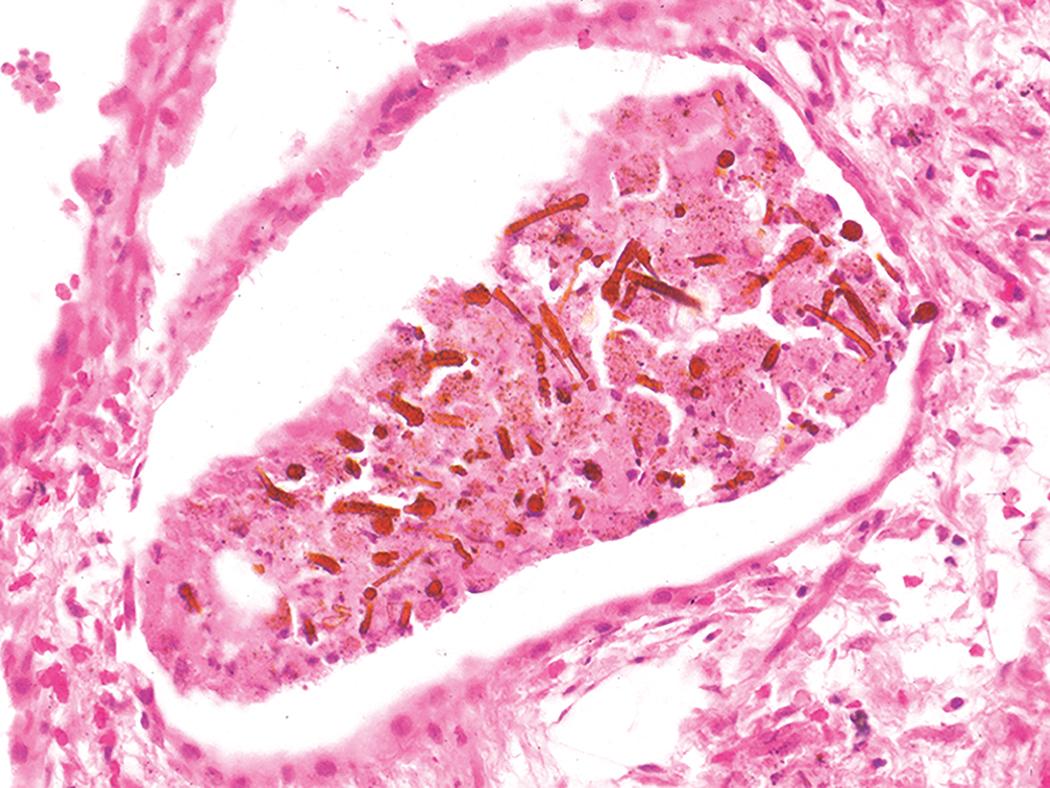
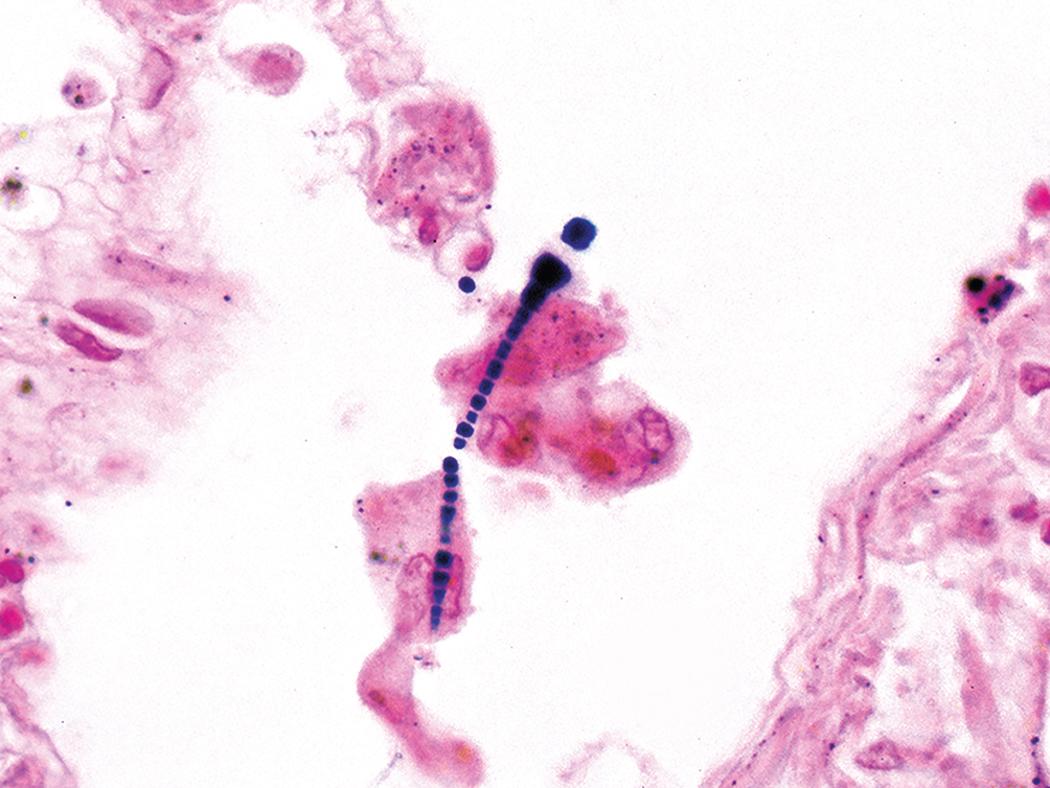
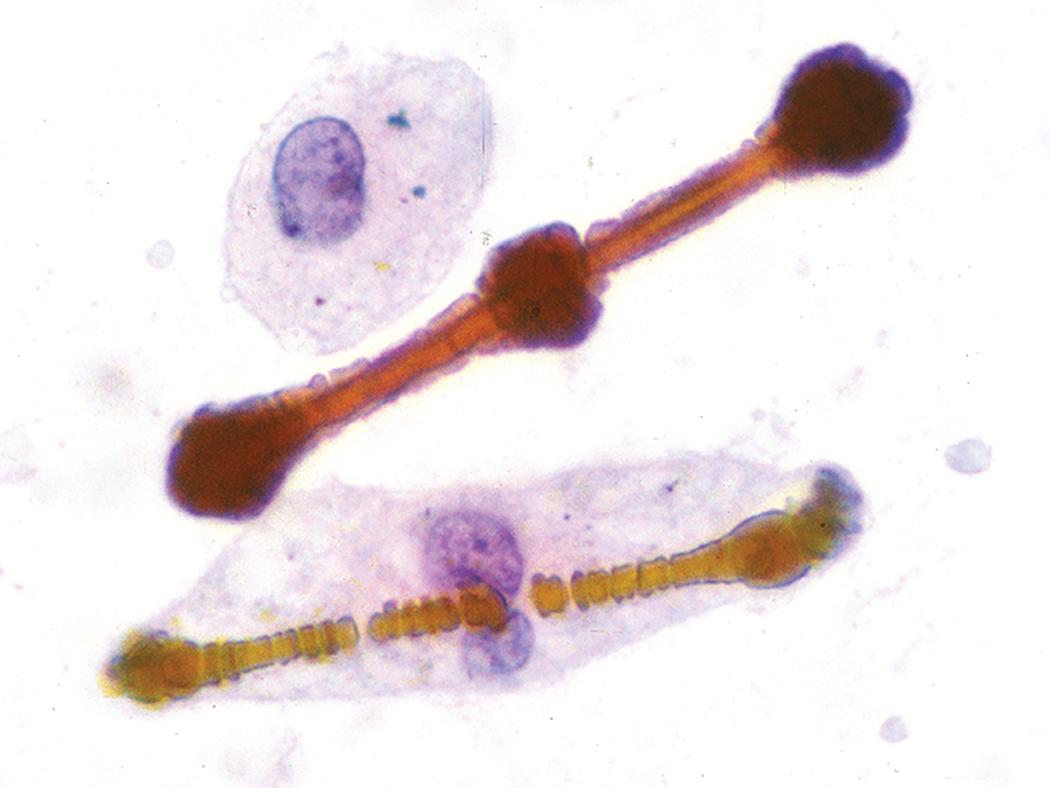
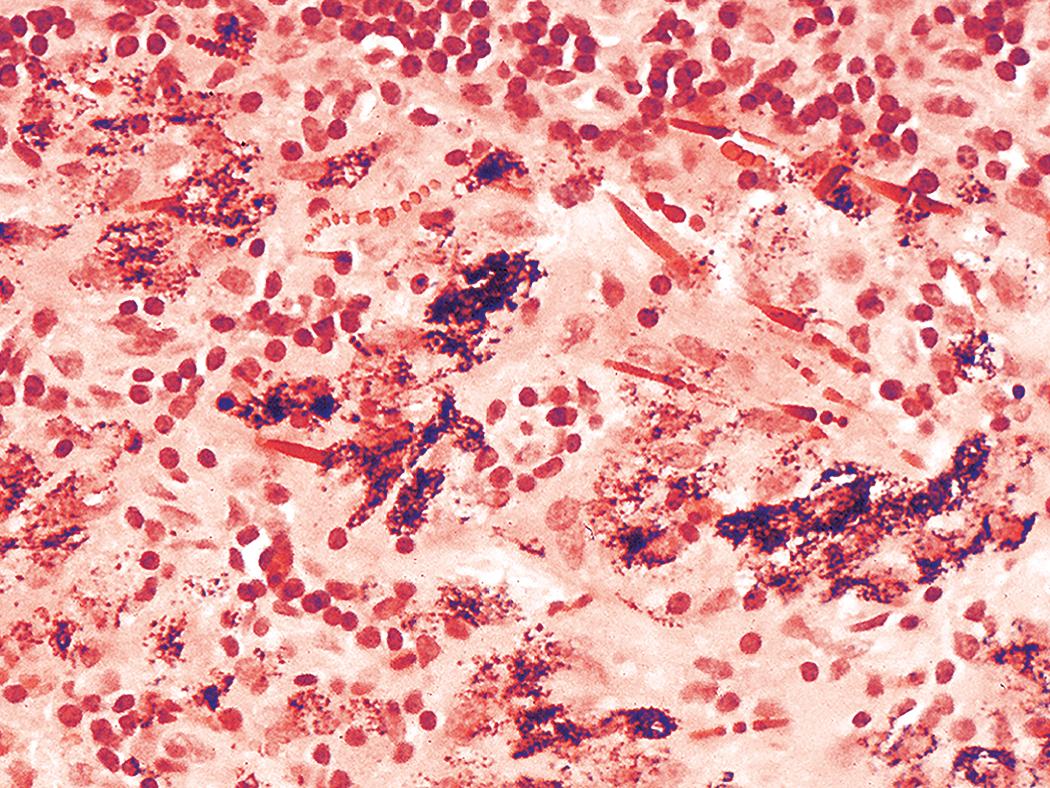
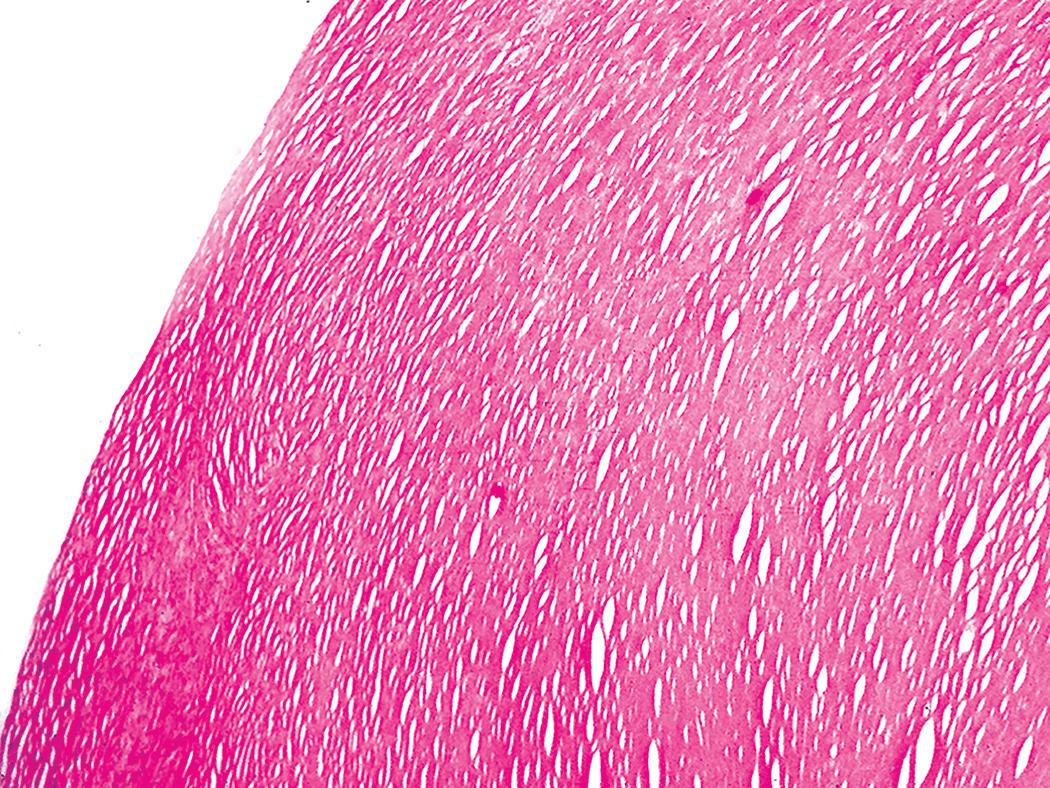
Digestion procedures have been developed for quantifying the content of asbestos in lung tissue ( Fig. 10.45 ). Any of the commercial forms of asbestos (chrysotile and amphiboles) may be identified in lung tissue from individuals with asbestosis by means of analytic electron microscopy ( Figs. 10.46 and 10.47 ). Performing lung asbestos fiber burden analysis in cases of diffuse interstitial fibrosis in which fewer than two asbestos bodies per cm 2 of lung tissue are identified in histologic sections is generally unnecessary, as the vast majority do not represent asbestosis. Such cases typically have lung asbestos fiber counts well below the range seen in asbestosis. However, this technique may be informative in cases of interstitial fibrosis with a compelling exposure history that lack the requisite concentration of asbestos bodies on histologic sections, particularly if pleural plaques are present. Occasional individuals are poor asbestos body formers whose lung asbestos fiber concentration is in the asbestosis range despite not meeting the minimum concentration of asbestos bodies on histologic sections.
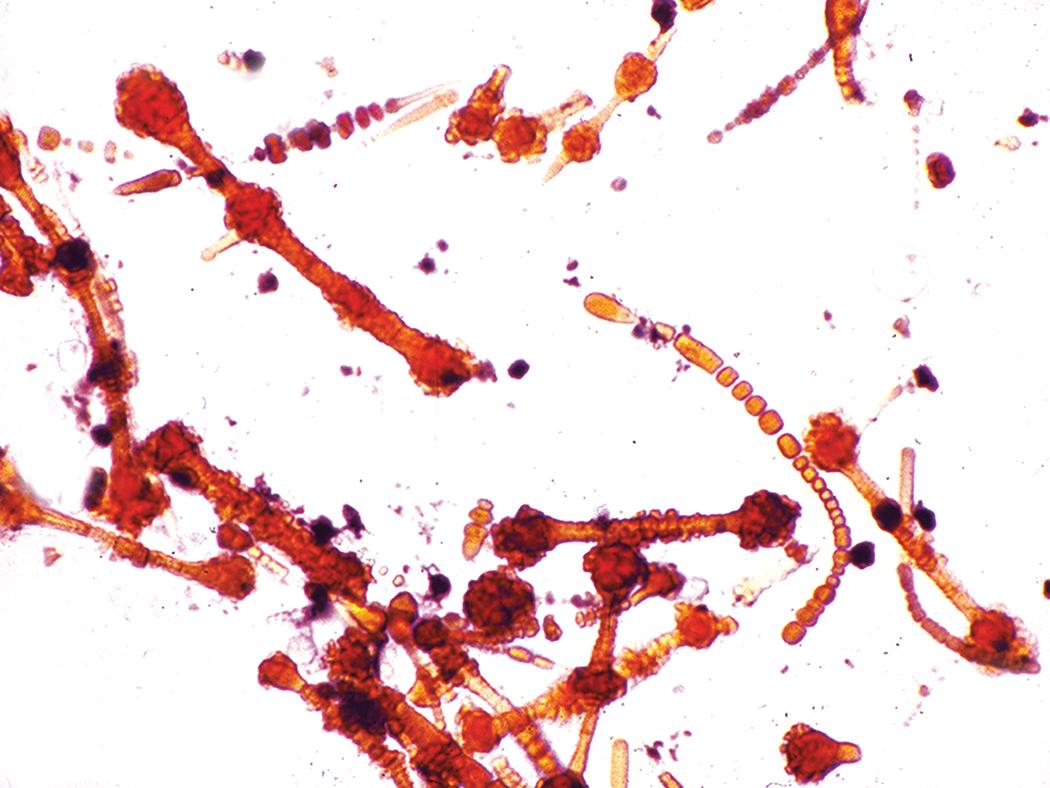
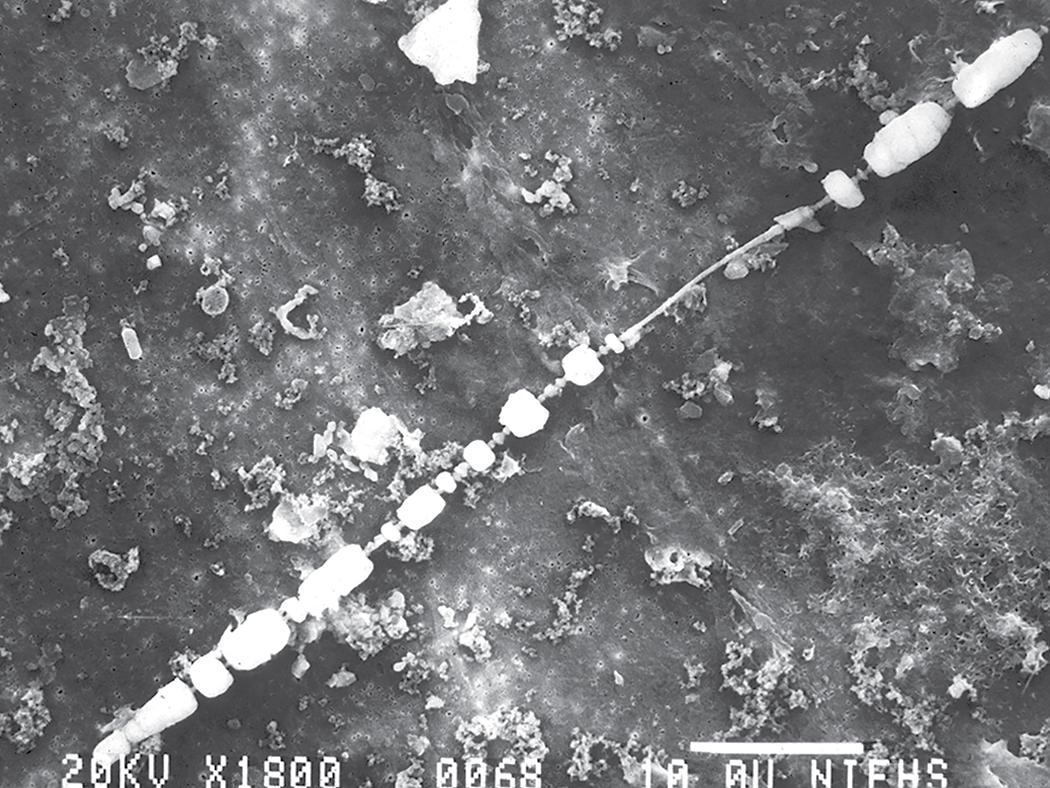
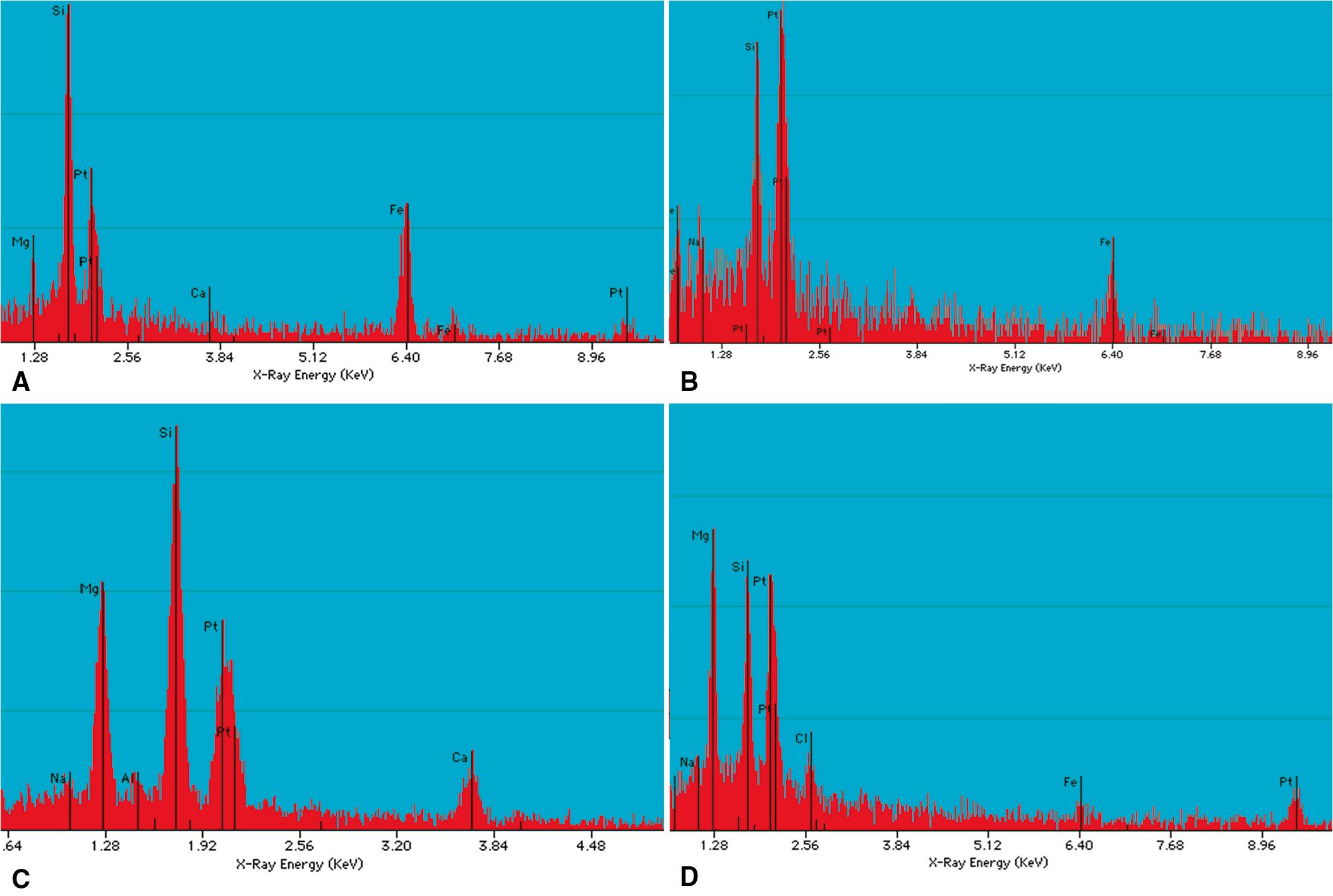
Asbestosis must be distinguished not only from usual interstitial pneumonia (UIP), nonspecific interstitial pneumonia (NSIP), and other forms of diffuse pulmonary fibrosis, but also from peribronchiolar fibrosis associated with cigarette smoking. UIP, which is the pattern of pulmonary fibrosis seen in idiopathic pulmonary fibrosis (IPF), is characterized by honeycomb changes, fibroblast foci, and the absence of asbestos bodies in histologic sections. Although asbestosis has a basilar subpleural distribution that is similar to UIP, honeycomb changes are rare and fibroblast foci are uncommon in asbestosis. Pleural fibrosis is far commoner in individuals with asbestosis than in those with UIP. The greater temporal uniformity of asbestosis as compared with UIP is reminiscent of NSIP. However, the fibrosis in NSIP exhibits a greater degree of spatial uniformity, lacks subpleural accentuation, and in cellular examples, shows more interstitial inflammation than asbestosis. Early asbestosis (grades 1-2) must be distinguished from both mixed dust pneumoconiosis (MDP) and respiratory bronchiolitis (RB), a form of small airway disease seen in cigarette smokers that is characterized by peribronchiolar fibrosis and pigmented smoker’s macrophages. Asbestos bodies are absent in RB. The peribronchiolar fibrosis in grades 1–2 asbestosis can also mimic burned out Langerhans cell histiocytosis, sarcoidosis, or chronic hypersensitivity pneumonia, but it is distinguished by the presence of asbestos bodies. Asbestos bodies must be distinguished from non-asbestos ferruginous bodies (pseudoasbestos bodies) that instead have broad yellow or black central cores ( Figs. 10.28 and 10.53 ) (also see Silicatosis section).
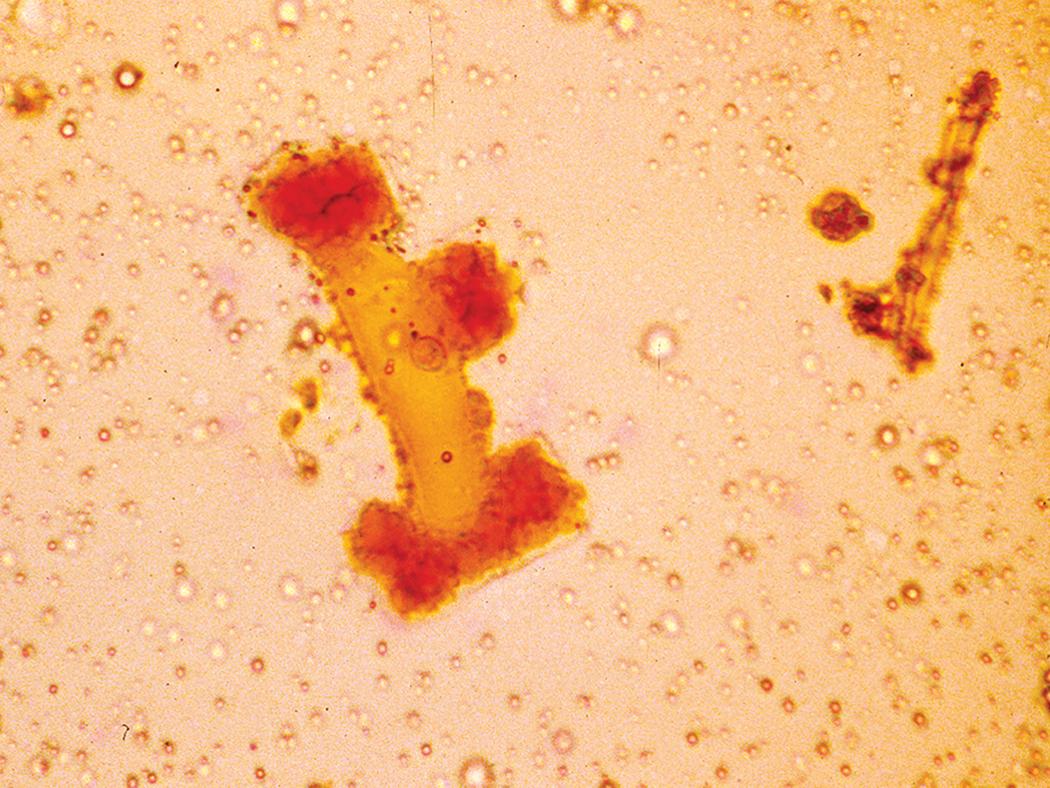
It is controversial whether the presence of fibrosis accompanied by one or more asbestos bodies on transbronchial biopsy is sufficient to diagnose asbestosis in individuals who have evidence of diffuse pulmonary fibrosis on radiography. , On the contrary, the absence of asbestos bodies on transbronchial biopsy does not exclude the possibility that asbestosis is the cause of pulmonary fibrosis.
Become a Clinical Tree membership for Full access and enjoy Unlimited articles
If you are a member. Log in here